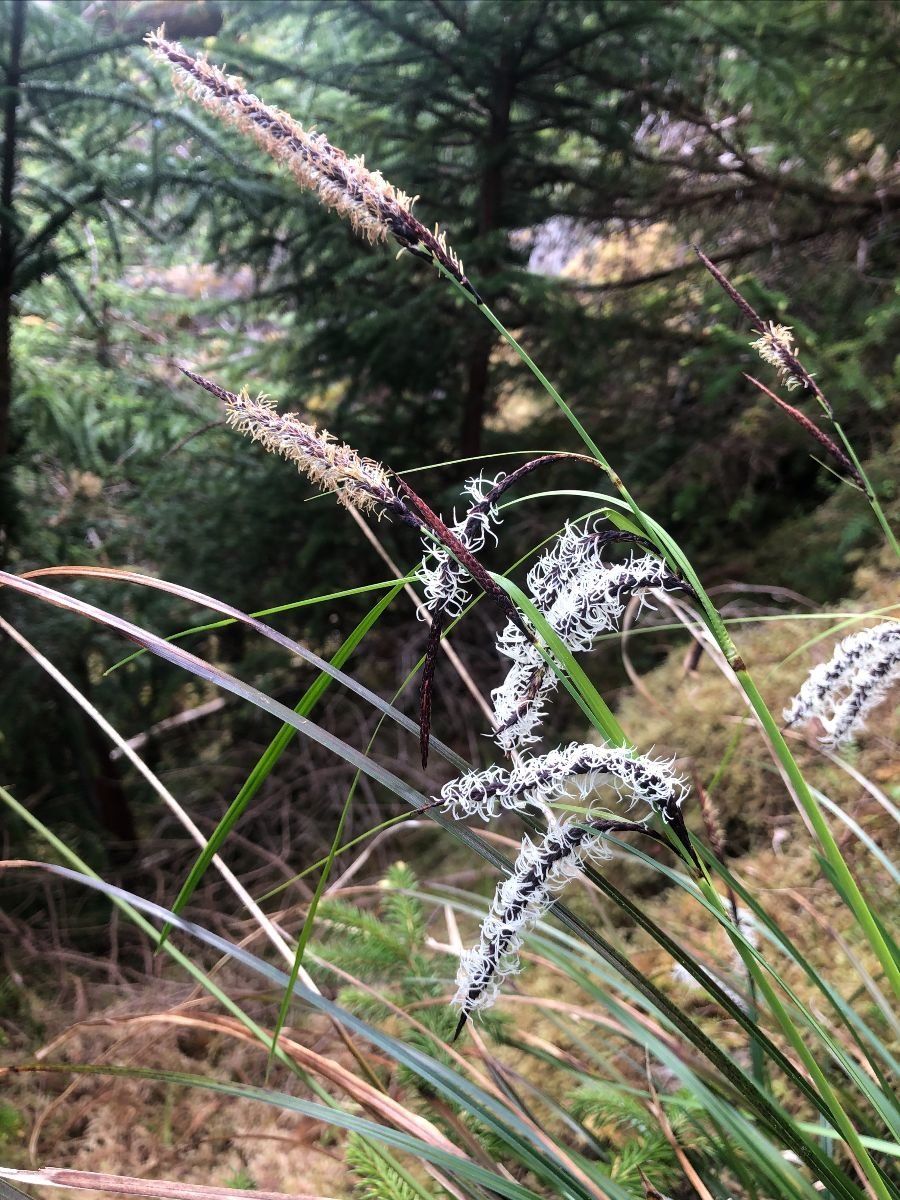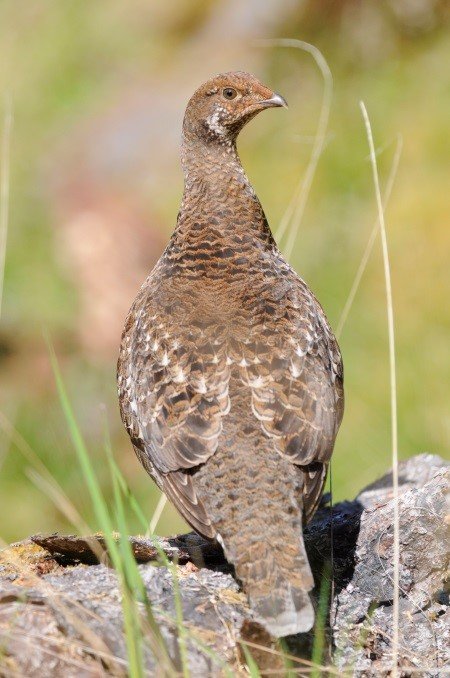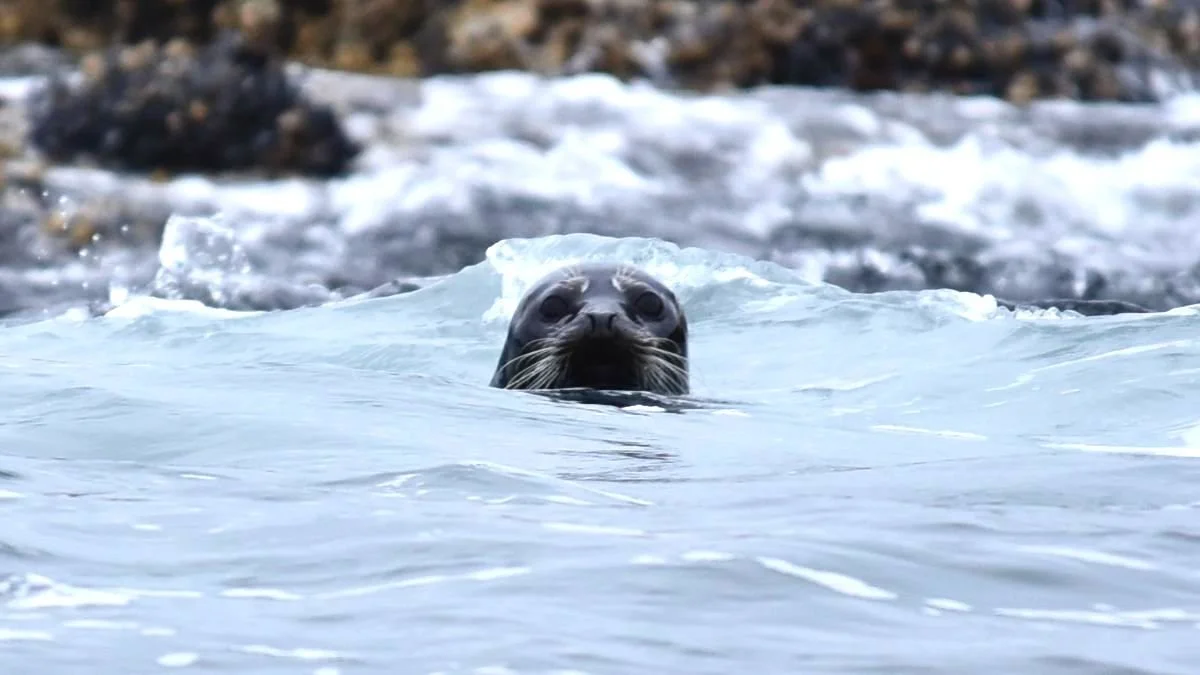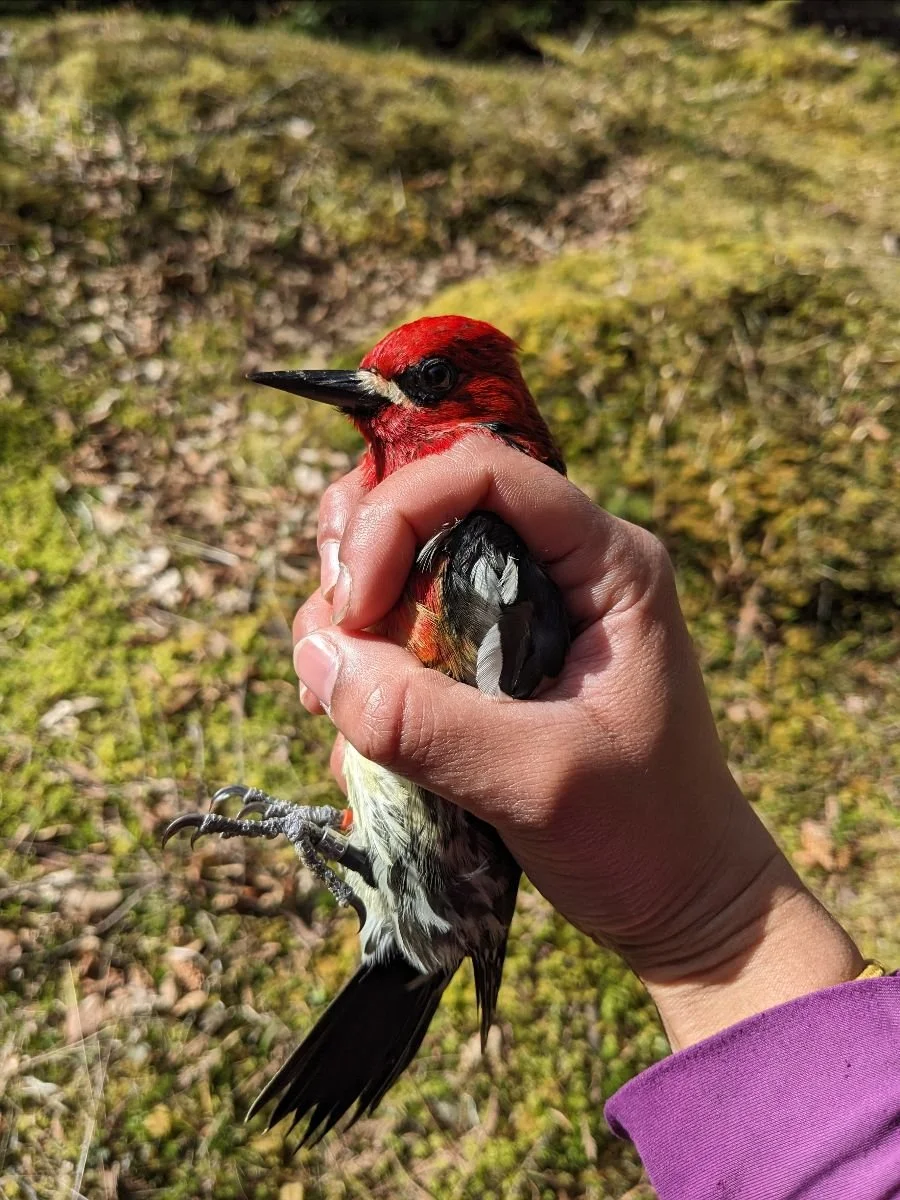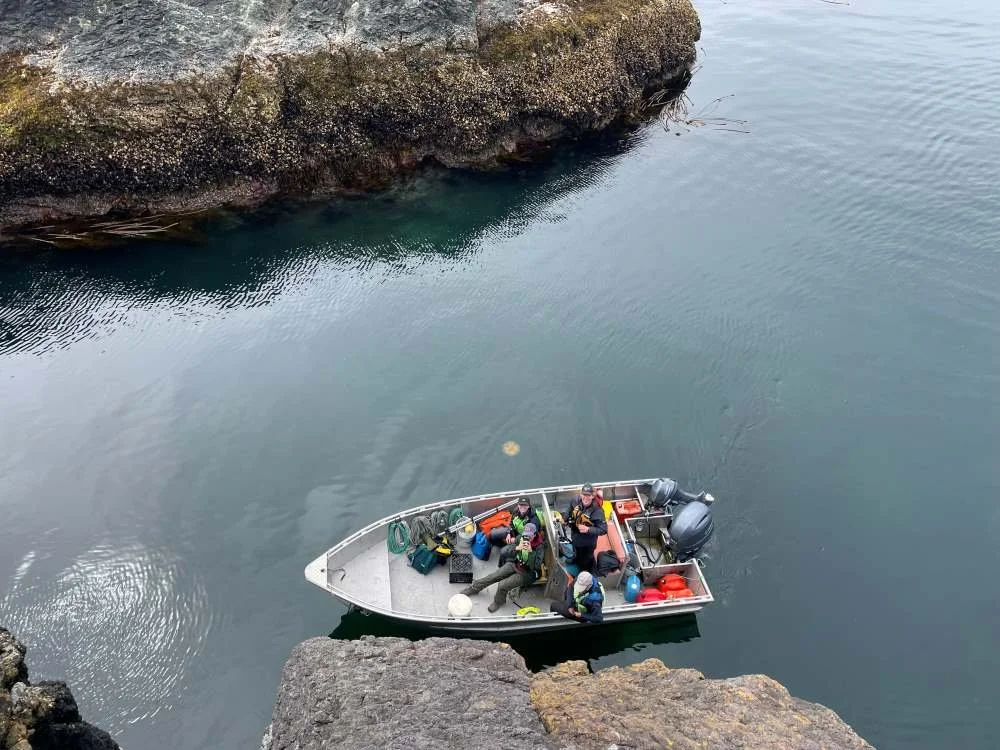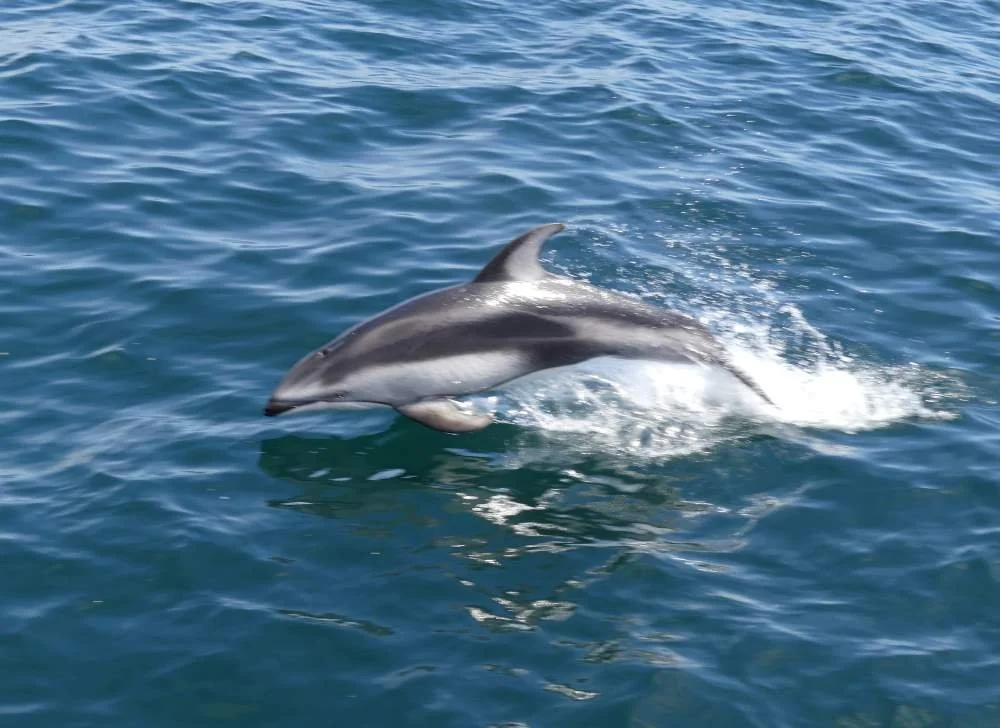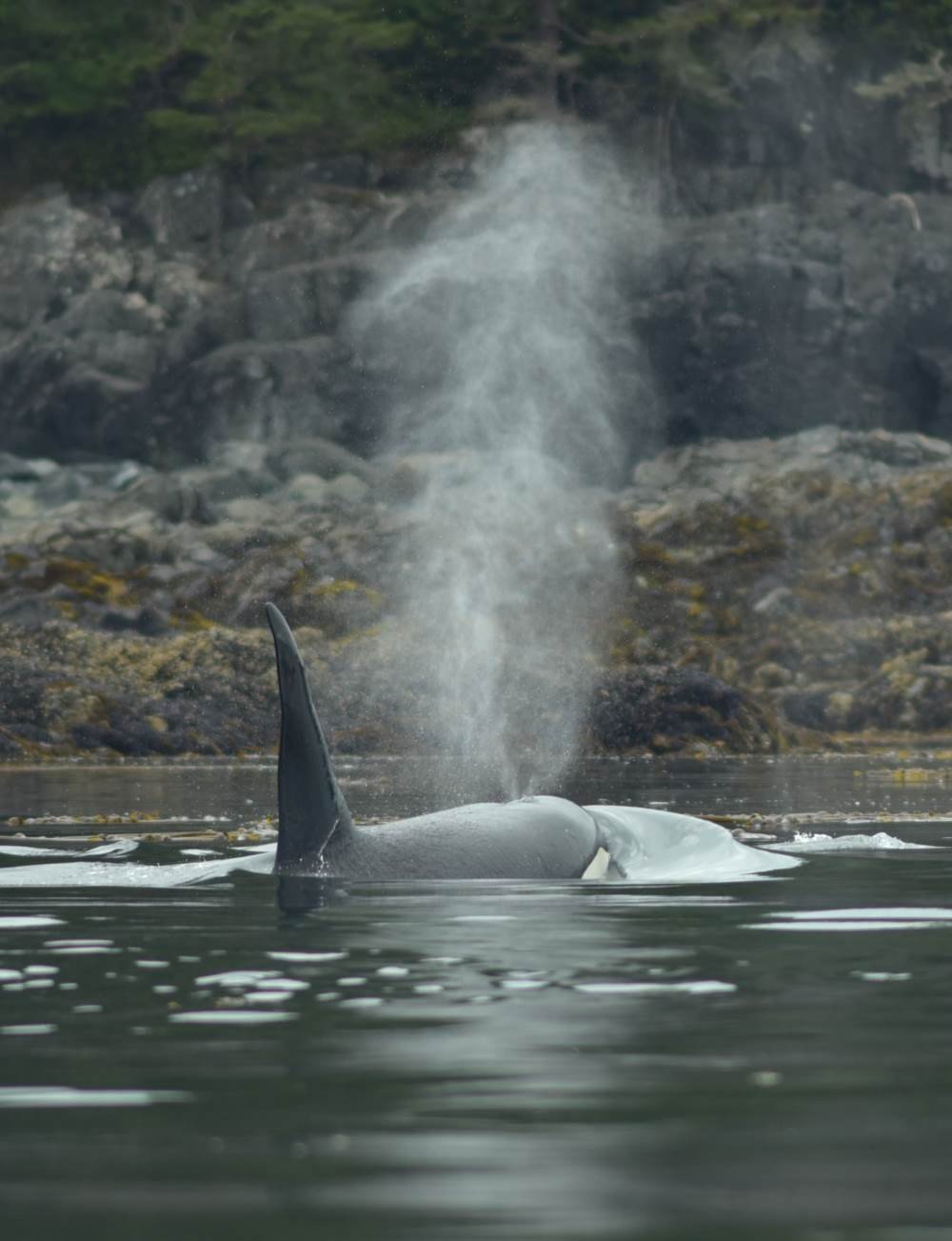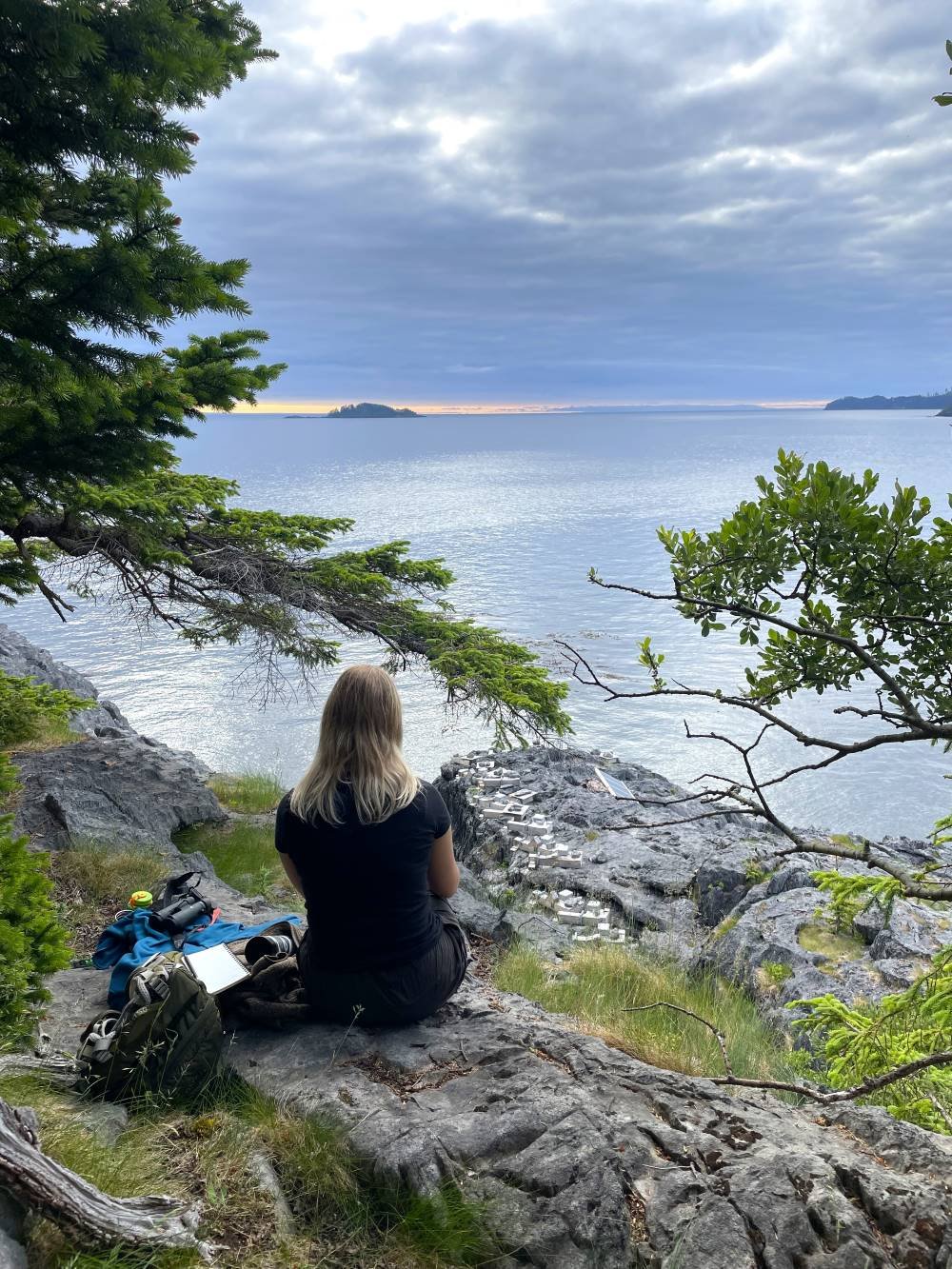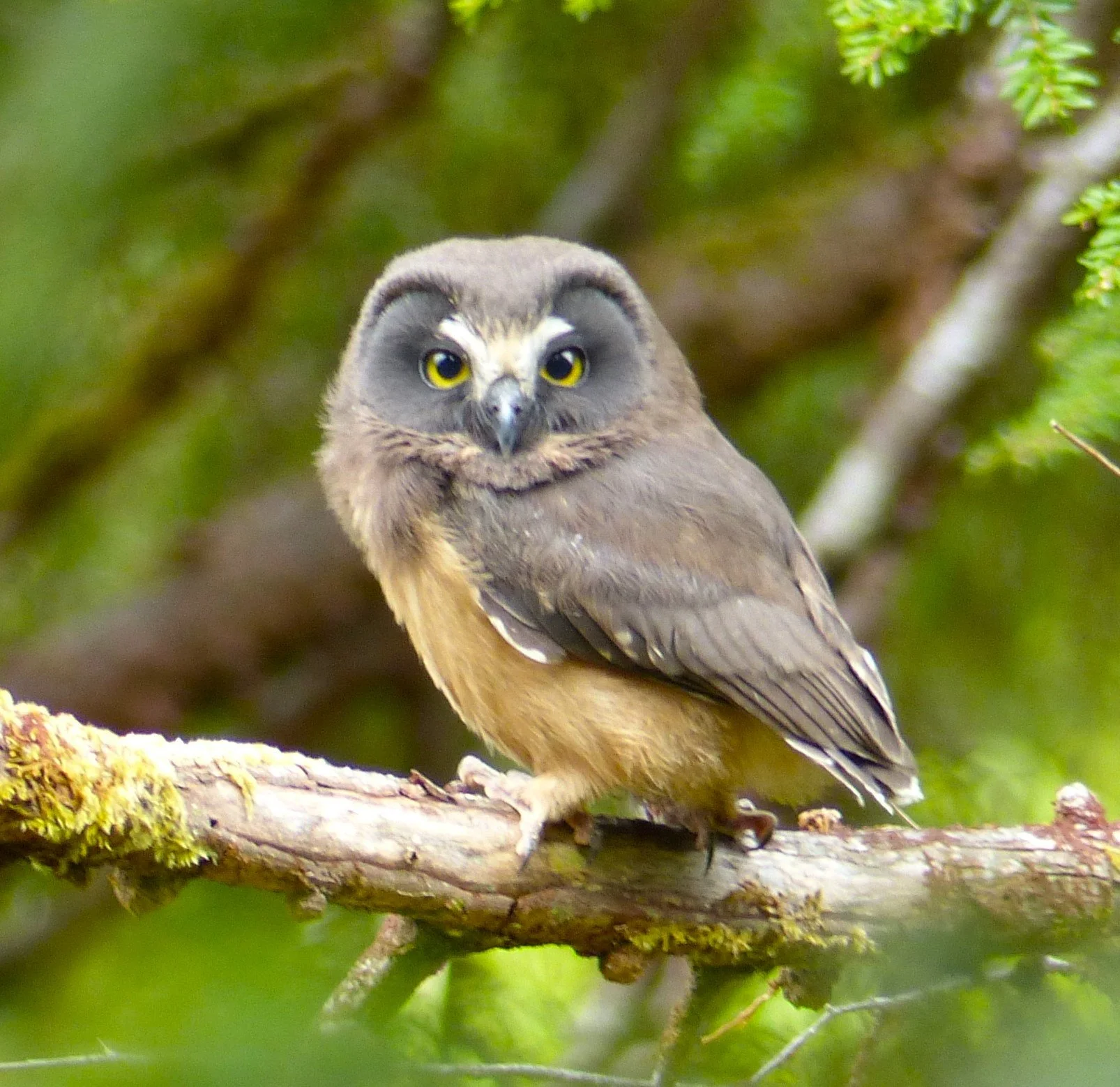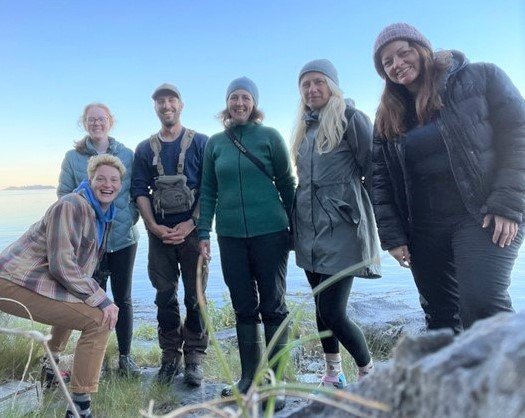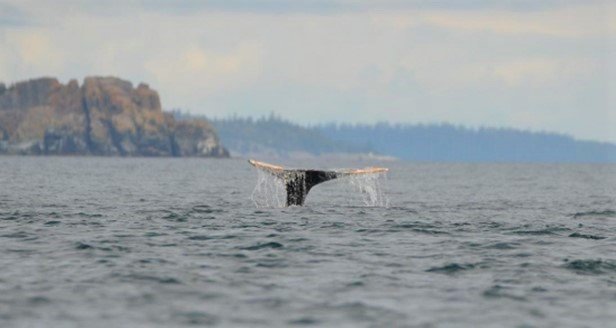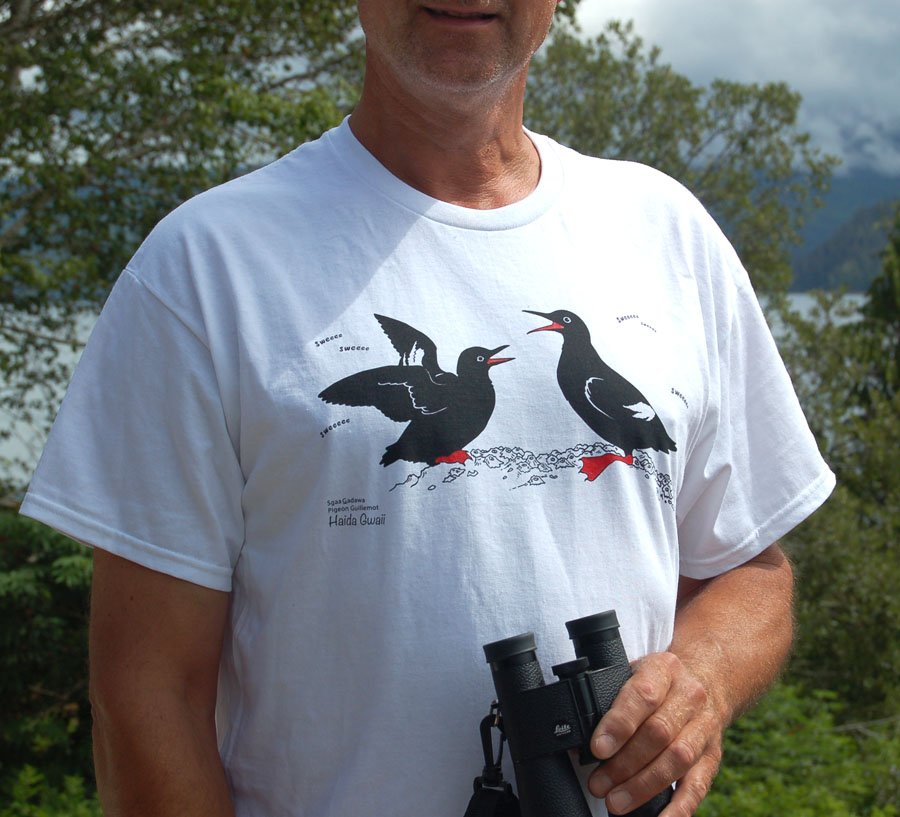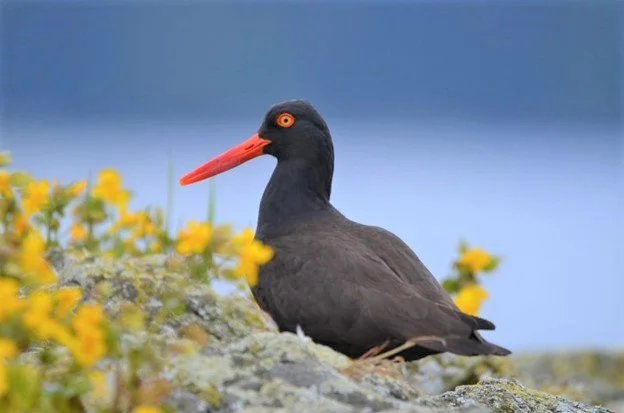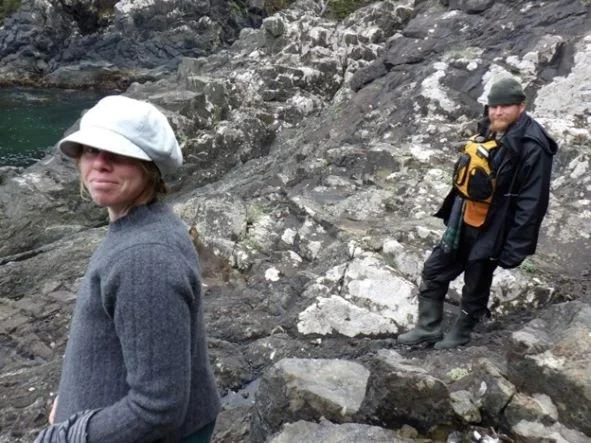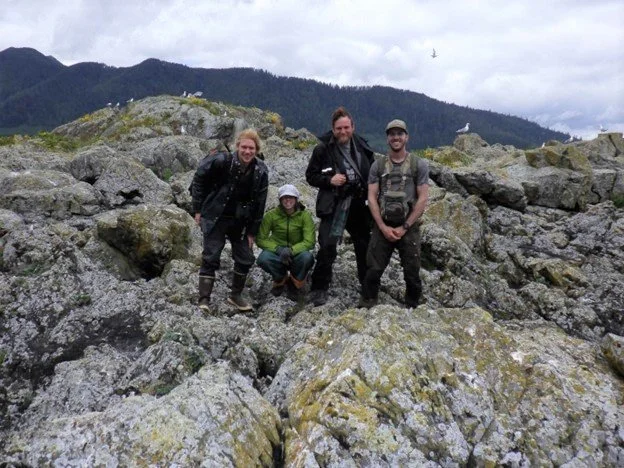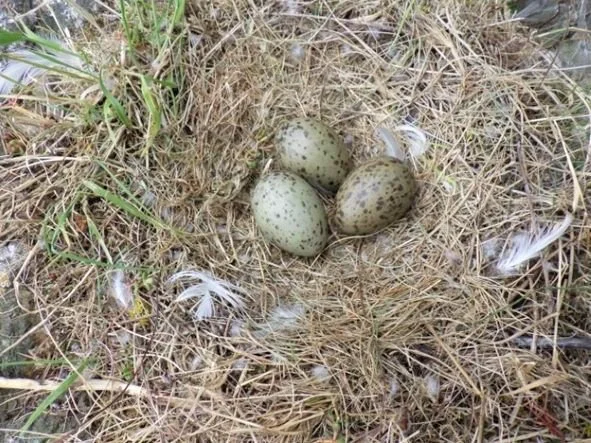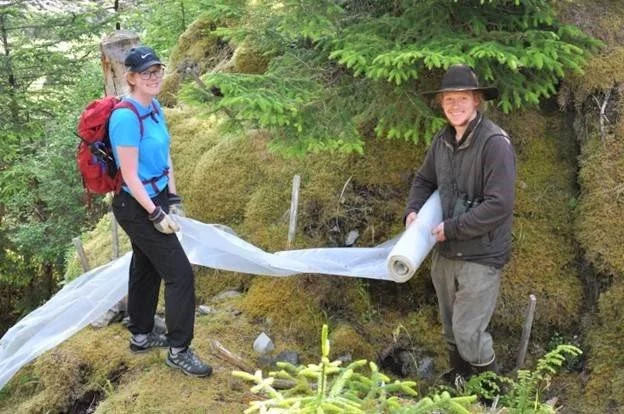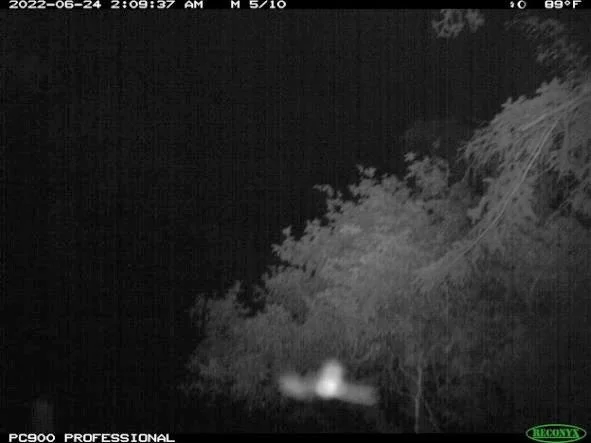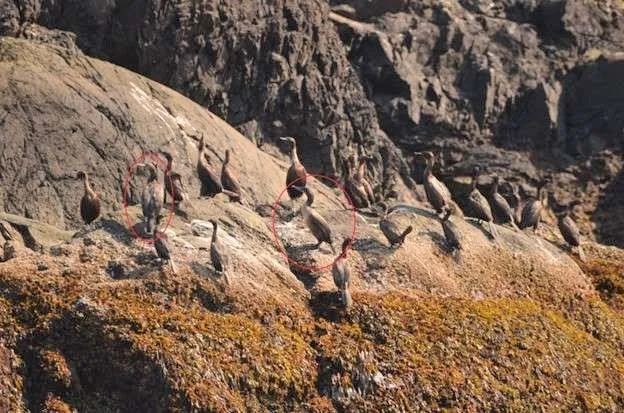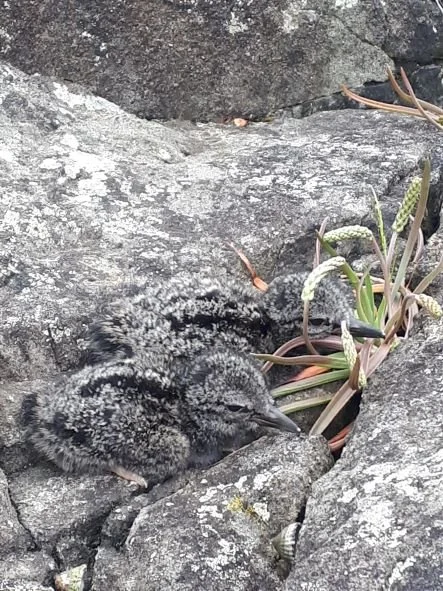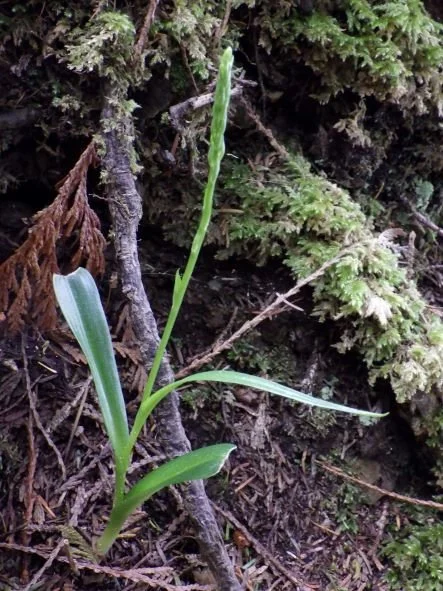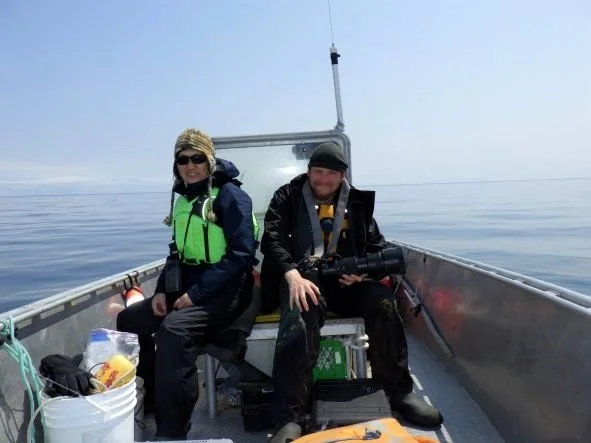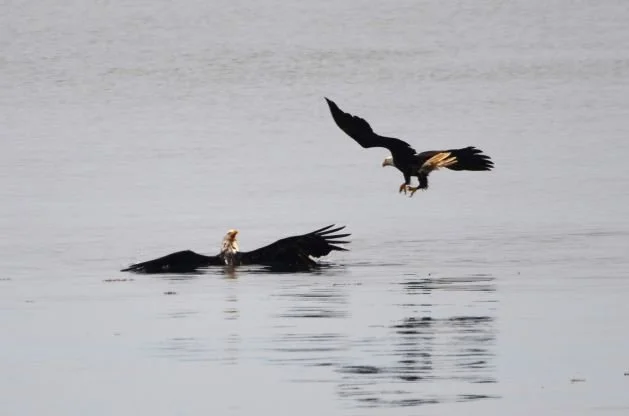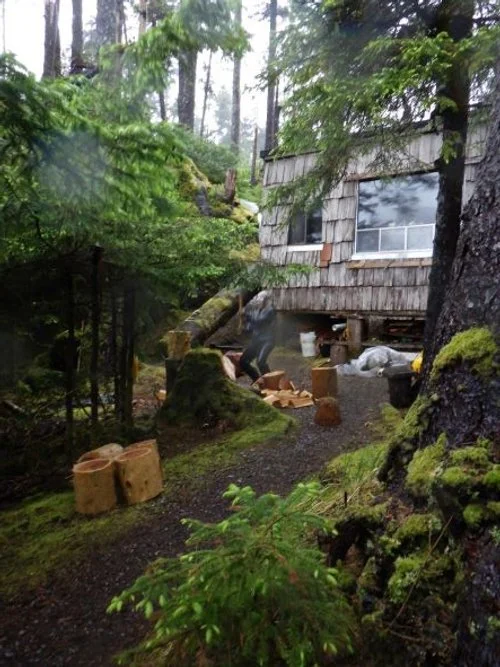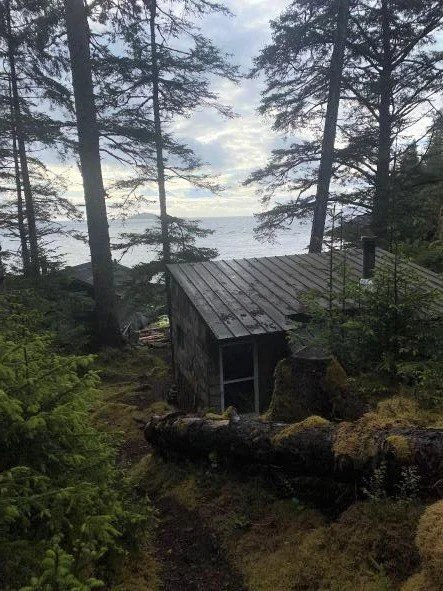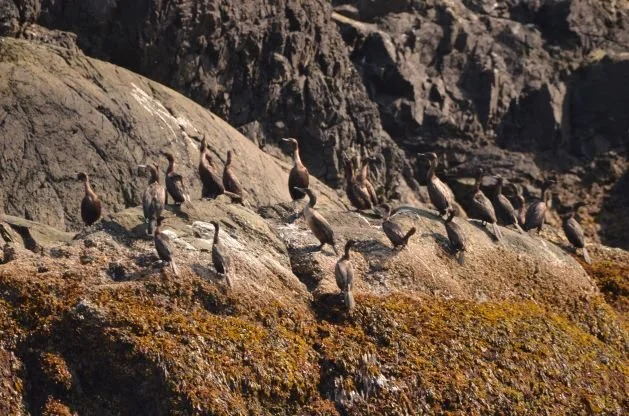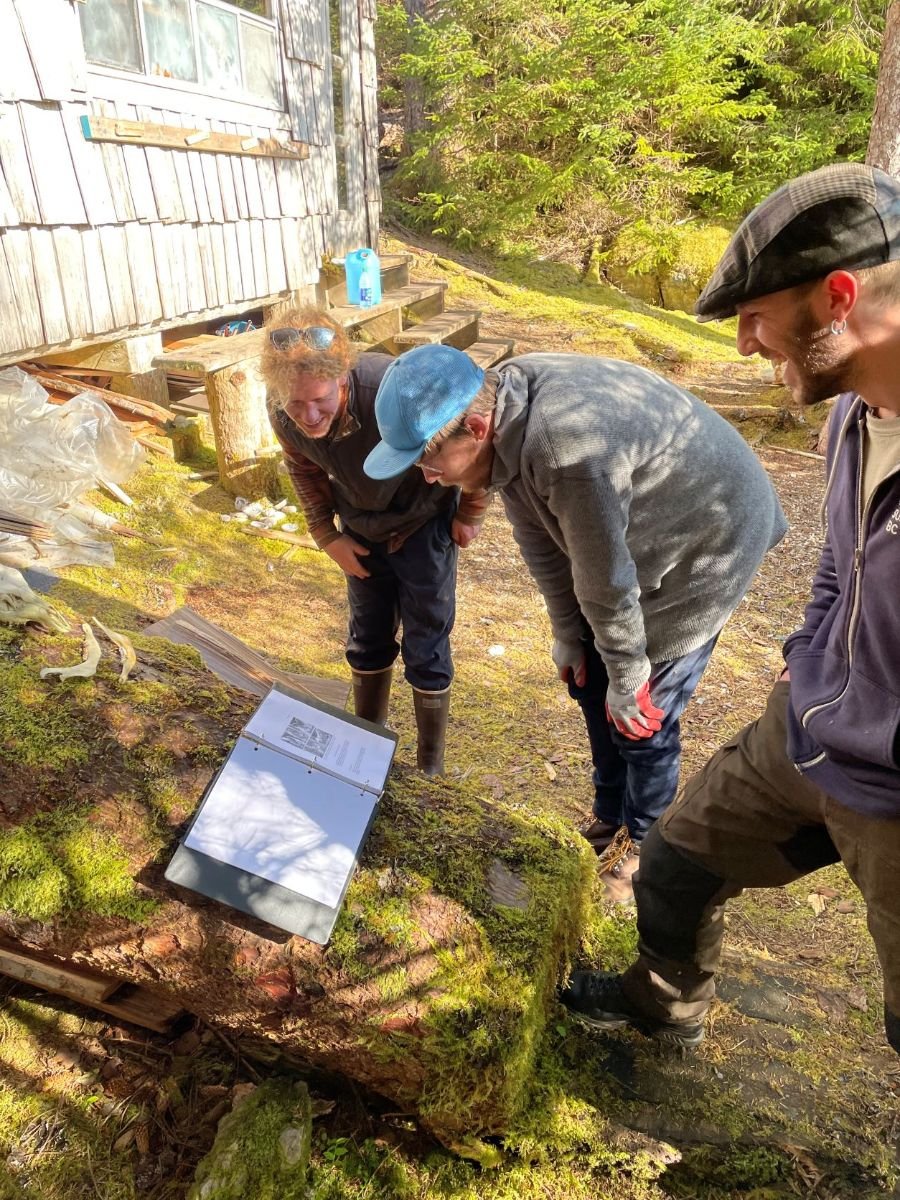2024 Fall Highlights
Black Oystercatchers (BLOY) are year-round residents in Xaana Kaahlii GawGaay (Skidegate Inlet) and this area is recognized as an Important Bird Area in part because of globally significant numbers of BLOY.
Photo by Liam Ragan
Upcoming Volunteer Opportunities!
Help out with the December 8 BC Coastal Waterbird Survey
and/or the December 15 Christmas Bird Count,
see details below:
2024 Christmas Bird Count
Skidegate/Daajing Giids/Sandspit - Sunday December 15
If you would like to participate in the 2024 Christmas Bird Count, please let us know. Everyone is welcome, no experience necessary!
North end (Port Clements, Rose Spit, Tlell and Masset) and Sandspit area residents contact organizer Margo Hearne: hecatebird@gmail.com
Skidegate and Daajing Giids area contact the Laskeek office: laskeek@laskeekbay.org
The Christmas Bird Count is organized so groups do not overlap the same area or count the same birds multiple times.
For a Haida Gwaii bird checklist go to our website (laskeekbay.org) go to resources > birding tools to download the list. https://www.laskeekbay.org/laskeek-bay-birding
For information and a map of other participating regions, go to: https://www.audubon.org/community-science/christmas-bird-count/join-christmas-bird-count
BC Coastal Waterbird Surveys
In October the LBCS crew continued the monthly BC Coastal Waterbird Survey at the Daajing Giids docks. The BC Coastal Waterbird Survey provides rewarding opportunities for volunteers to contribute their knowledge of coastal habitats and waterbirds. This initiative has been happening since 1999. The data collected directly supports the conservation of British Columbia’s waterbirds.
The survey involves counting waterbirds at specific locations along the BC coast each month. Volunteers will learn bird identification skills from our Biologists and will have access to binoculars or a spotting scope, but are welcome to bring their own equipment as well.
Please email our office if you would like to learn more and get involved, laskeek@laskeekbay.org
Beginner and experienced birders welcome!
December's survey will happen in Daajing Giids on Sunday Dec. 8., meet at Spirit Square at 3pm.
Important Bird Areas / Key Biodiversity Areas
by Tony Gaston
Over the past few years, LBCS has been collaborating with Birds Canada over the designation of "Important Bird Areas" (IBA) in Haida Gwaii. What are IBAs and where is the initiative going?
Starting in the 1980s in Europe, and subsequently expanding to North America and elsewhere, Birdlife International designated a series of sites as "Important Bird Areas" (IBA) based on their supporting, for at least part of the year, more than 1% of the world population of a given bird. The designation of these areas was intended to flag up places of conservation concern for birds. In Canada the designation of appropriate areas has been carried out by Birds Canada. Haida Gwaii is assigned many IBAs because the islands support much more than 1% of many seabird species' populations, being an important breeding ground for Cassin's Auklet, Marbled Murrelet and Ancient Murrelet and also an important wintering area for others (e.g., Western Grebe, Pacific Loon).
Where possible, local guardians are assigned who monitor the IBAs for conservation concerns. The Laskeek Bay Conservation Society performs this function for the waters of Laskeek Bay, which qualifies as an IBA on the basis of the Ancient Murrelet and Black Oystercatcher populations that breed there and the number of Marbled Murrelets occurring throughout the year. One of the responsibilities of the IBA guardians is to check on the status of bird populations in their IBA and our annual monitoring surveys, initiated before Laskeek Bay was declared an IBA, do this task to perfection.
More recently, Key Biodiversity Areas (KBAs) have been adopted by a network of international organizations under the International Union for Conservation of Nature, (IUCN) as a framework for identifying important biotic areas (Key Biodiversity Areas, KBA). As part of this global initiative, the Birdlife International IBAs are now transitioning to KBAs (http://datazone.birdlife.org/site/ibacriteria).
The main aim of the KBA program is to secure the long-term protection of sites that are important for biodiversity. To qualify for IBA/KBA status, a site designation must be based on robust data and the application of scientific criteria, such as the proportion of the global or regional population of each species using the site (Handley et al. 2022). LBCS has been assisting with this process which should create a higher profile for sites of high biodiversity and hence high conservation concern within the archipelago.
Marbled Murrelet Photo by Jo-Anne Castillon
Marine Plastics Monitoring
Our marine plastics monitoring is now a year-round project, with several small crews collecting samples from Laskeek Bay and Skidegate Inlet in August and September. We completed beach debris surveys at Crow Valley beach on East Limestone Island and South Beach on Reef Island. Gwaii Haanas staff collected water and sediment samples from locations in Gwaii Haanas, including the west coast of Moresby Island. Slack Tide Enterprises and Jake Pattison obtained sediment and water samples from the west coast of Graham Island. Samples are sent to an Environment & Climate Change Canada lab in Ottawa and ECCC will send results back to us this winter. Based on those results, we will choose a subset of sites to sample more frequently next year. Our main goal for this year is to get broad geographic coverage, to get a sense of the spatial variability of microplastics in Haida Gwaii's marine environment.
Marine Plastics sampling: a trawl net is towed at a slow speed of 1.5 knots by Max and Rian, near East Limestone Island.
Photo by Madeleine Springle
Happy Anniversary to Us!
2024 marks 35 years of operations for the Laskeek Bay Conservation Society! To celebrate, we held a community event at the Saahlinda Naay Haida Gwaii Museum on November 2nd. Thank you to those of you who were able to attend, we estimate 50 people turned out for our event on a busy Haida Gwaii weekend. We were happy to see some familiar faces from previous staff, Directors, and volunteers, as well as many new folks of all ages.
There were 12 taxidermy birds on display, from the Haida Gwaii Museum collection, which people enjoyed sketching and getting a close look at. A couple comments were: "Seagulls are surprisingly big!" and "Why do Rhinoceros Auklets have such long whiskers?" Haawa to Nathen Peck of the Haida Gwaii Museum for organizing this part of the event.
Photos below by Mary Morris and Matt Peck
Another popular display was the Pigeon Guillemot nest box, with accompanying video clips of the PIGU parents tending eggs and feeding newly hatched chicks. Haawa to Jake Pattison for his work on the box design and construction over the past years, and Haawa to Rian Dickson for putting this display together. Conveniently, Greg McClelland and Ariel Lenske of the Canadian Wildlife Service were on Haida Gwaii on Nov. 2nd, and were able to work with Rian and Jake on some fine tuning of the nest box camera system while at our event (see photo below).
Photos below by Mary Morris
Our outreach Worker Eilean McCutcheon gave people lessons in seabird identification and spotting scope use, as they enjoyed the gorgeous ocean views from the Haida Gwaii Museum's large windows. The birds were cooperating and I heard people identifying loons, cormorants, and grebes, in the bay.
On Haida Gwaii we are fortunate to have a steady supply of young and energetic volunteers from the university students who attend the Haida Gwaii Institute each semester. The HGI students helped carry gear in to the museum for the 35th event, they ran the merchandise table, they helped people with door prizes and snacks, and they carried gear back out to our cars at the end of the event. We send a huge Haawa to these students and wish them all the best as their semester draws to a close.
Photo below by Matt Peck
The new t-shirt to commemorate our 35th anniversary year was unveiled at the event. It features a Black Oystercatcher Chick, and the Haida name for this bird, Sgadang giit'ii / Sgaada.nga gidga. The eco-friendly fabric and printing are done by the Kindred Coast company in Parksville, and the design is by our Executive Director Judy Hilgemann, so it's a local BC product. Shirts will be available very soon on our website. Adult shirts are $40, children's shirts are $35. If you would like to order one right away, please email laskeek@laskeekbay.org for more information on available sizes and colours.
Noa and Taya Dickson-Brown modelling our new kids' t-shirts. Adult t-shirt colours are green, blue and teal.
Thank you for reading our newsletters, and for sending feedback and comments. Look for our Winter Newsletter early in 2025, as we continue with some winter birding activities and begin the next field season planning. We hope to see some of you in the new year for various projects and outreach, or for field season volunteering.
The entire Laskeek team would like to extend a huge thank you to everyone who donated in response to last week's call for donations for travel expenses for our Biologist Rian Dickson to attend the 2025 Waterbird Society and Pacific Seabird Group Joint Meeting in San Jose, Costa Rica, Jan. 6-9.Donations remain open, thank you again for helping Laskeek be a presence at this international conference. Rian's conference presentation on Ancient Murrelets will be made available on our website early in the new year.
Haw'aa/Haawa!
Donations to support our ongoing programs remain crucial to our continued success - please click on the Donate button below to donate via our website. Tax receipts will be issued.
World Seabird Conference
Rian Dickson, our Lead Biologist, has been offered the opportunity to present a summary of our long-standing Ancient Murrelet monitoring program at the Pacific Seabird Group/Waterbird Society joint conference in January 2025, in Costa Rica. This is an exciting chance to share our work with colleagues and connect with other researchers and organizations that are studying seabirds, herons, gulls, and other waterbirds.
We will also be able to promote Laskeek Bay Conservation Society, showcasing the work of our citizen science volunteers and student interns, as well as our public outreach and school programs, and our 35 years of success as a non-profit environmental organization.
Please consider assisting us with travel costs, any amount is greatly appreciated! Thank you for your time and consideration, and we look forward to reporting back to everyone early in the new year with results and findings from this international conference.
Haw'aa/Haawa!
How to donate:
Click on the Donate button below to donate via our website.
Or send an e-transfer to our office email: laskeek@laskeekbay.org
Tax receipts for donations over $25 will be issued.
2024 Limestone Log 7 (Raven Stashes)
Volume 35, Issue 7
July 12 - 20, 2024
Above: Field sketch by Lori Waters. A collection of items found near Raven stashes, in the forests of East Limestone Island.
Above: Field camp research cabin. Photo by Kaitie Riddell
Weeks 13 & 14
It’s the final week of the season! This wraps up Laskeek Bay Conservation Society’s 35th year! We reflect and give thanks Haw'aa Hawaa to all the volunteers, interns, researchers and staff who have made it a safe, productive and magical season. The only constant around here is change— we have observed the rhythms and cycles of change throughout the season, both the people who have come to learn and help with our long-term monitoring, as well as the cycle of life in the more-than-human world.
As new faces and friends have come and gone from camp, spring has transitioned into summer and another season’s cohort of birds have been laying eggs in burrows and raising fledglings. What a joy to observe and document! To be still and diligent enough to learn the secrets of our feathered friends. In addition we record subtle shifts over time, that’s why long-term data sets are so important!
Red-breasted Sapsucker. Photo by Amaya Black.
Marine Debris
We were joined in camp this week by Nick Pfeiffer from Germany during his epic 7 month trip around Canada, (so far Haida Gwaii has been the highlight for him, but don’t spread it around). Kaitie Riddell joined us from Ucluelet where she works at the Ucluelet Aquarium.
The final week of the season was jam packed with diverse projects. Crew ventured to the south side Reef Island for a marine debris survey and beach clean-up, as well one on East Limestone Island. Interesting finds include a kid’s toy waffle, plastic bottles from all over Asia and grass growing out of a hunk of Styrofoam. Nature finds a way!
Marine Debris – Check out Marine Debris initiative in action on the Ucluelet Aquarium Instagram, or follow the link below:
chrome-extension://efaidnbmnnnibpcajpcglclefindmkaj/https://uclueletaquarium.org/wp-content/uploads/marine-debris-final-report.pdf
Kaitie, Amaya, Rian and Nick and marine debris cleanup results.
Wildlife Trees
Rian, Nick and Kaitie smashed the record of measured wildlife tree on East Limestone! They used a range finder, clinometer and measuring tape to calculate the tree height and the height to the cavity that is being used for nesting. Tree-ginomety! In addition to height, the team mapped and tagged all the new trees used for nesting this season.
Wildlife Monitoring Cameras
While the tree team clamored through the understory, Amaya changed batteries and downloaded deer camera photos—part of our long-term invasive species monitoring. The team also checked raccoon monitoring cameras.
Here is what Nick and Kaitie have to say about their experiences on East Limestone Island:
Blog entry - July 14th by Nick
The Raven Insight
"I think the most exciting and mind-blowing thing I got to learn ‘bout the animal world, is that ravens are actually awesome!! Like everybody knows that crows and ravens are intelligent, but gosh, did you ever hear a bird sounding like a waterdrop or like a cat? And then ravens are kind of realizing what we humans usually do. For example, they see us arriving at Boat Cove (Heart Cove) with bags full of debris and as soon as we leave it, they would go and check out what cool things we’ve brought. AND: they are frickin’ all black! That is so elegant."
Above: Kaitie and Nick on sea survey, with Rian driving the boat.
Blog Entry - July 17th by Kaitie
Life’s Cool
Life has such a unique way of bringing people together, and I think Limestone Island is one of those few magical places where really special moments happen. Where people from all walks of life can come as they are and take part in something new, something fun, something adventurous and exciting.
I honestly was first drawn to Haida Gwaii because I was told the moss was epic, which I can definitely confirm, indeed it is! But I never imagined being able to experience Haida Gwaii in this way, and I think that’s what makes Laskeek Bay Conservation Society so unique and special. The way this very inclusive and immersive learning experience has created a way to show people some of the natural history of this area and also the rich cultural history of Haida Gwaii, it’s truly so beautiful.
I can’t wait to share my experience with my friends, family, colleagues, and anyone else I have the opportunity to cross paths with. I’m excited to let them know that they too can volunteer even if they don’t have a formal background in biology, or science in some way, that they are most welcome as long as they’re willing to maybe step a little outside their comfort zone and try something different, but so impactful and helpful to the work you all are doing.
Thank you so much Laskeek Bay Conservation Society for this amazing opportunity to learn and also see and feel the moss I’ve dreamt of. I will never forget this time here, the people I’ve met and I hope to be back here again for years to come.
Until then, I wish you all the best bird sightings and cool findings and I will see you all again sometime soon!
Cheers!
Kaitie Riddell
PIGU Chick Census
Thanks to some weather, the crew had to postpone leaving camp by one day, which allowed Rian and Amaya to conduct a Pigeon Guillemot (PIGU) chick census. The PIGU nest boxes are on a steep rocky cliff, which crew scrambled down to count this year’s hatchlings.




2024 Field Season End Note:
Pack it in, pack it out, clean it up! With the hard work of Nick, Kaitie, Amaya and Rian, we were able to pack out all of our research materials, deep clean, inventory and pack the boat to haul out garbage from beach clean ups. Thank you again for all contributions and volunteers near and far, to another incredible season. And thank you to East Limestone Island and K’uuna Gwaay Conservancy.
We hope to see some of you back on East Limestone Island again one season soon! Please note that volunteer spaces begin to fill up as early as February each year, so sign up as soon as you are able. Watch our website early in the new year for details.
We thank all of you for reading our newsletters, for your feedback and for the donations - these make it possible for us to keep going! We are happy to report we have an abundance of news and photographs to continue to share, and some of our programs continue throughout the year, so look for a 2024 Fall Newsletter in November, and a 2025 Winter Newsletter early in the new year.
One final point - for those of you on Haida Gwaii, we are planning a 35th Anniversary Event on November 2, at the Kay Centre in Skidegate, we hope to see you there! Details will be released closer to the date, but there will be feathers!
Haw'aa/Haawa!
Donations to support our ongoing programs remain crucial to our continued success - please click on the Donate button below to donate via our website. Tax receipts will be issued.
2024 Limestone Log 6 (Orcas and Oyster Catchers)
East Limestone Island News - Week 11 & 12
We’ve had an eventful and great two weeks in camp. From June 28th to July 5th we were joined in camp by Professor David Green from SFU and his research assistant Katie Chettle to celebrate BLOY (Black Oystercatcher) day! We celebrated the newly minted holiday by conducting a week’s worth of Black Oystercatcher adult and chick banding, as well as territory visits and collecting prey remains. We went ashore to conduct surveys on Reef Island, Low Island and the Skedans islands.
Below, Katie releases an adult Black Oystercatcher after it was caught to be weighed, the tarsus (toe knuckle to elbow) to be measured, as well as a feather and toenail clippings collected for DNA analysis. The large Black Oystercatcher chick in the lower photo has grown big enough to be banded. Banding chicks helps determine individuals, help age them and see where they go throughout their lives.
Banding increases the number of marked birds in the overall BLOY breeding population each season, and provides important information on breeding sites, pair longevity, adult survival and nesting success. (Please note, LBCS follows research permit guidelines for all wildlife handling practices.)
Sea-watches
Interspersed with Black Oystercatcher research were sea-watch surveys from the Lookout Point Blind, to look for dolphins, whales, and porpoises, oh my! While only two Harbor Porpoises were spotted during the official surveys, researchers observed an incredible incidental orca pod sighting of transients cruising the shoreline during the Black Oystercatcher surveys. The team is eagerly awaiting confirmation of ID of the pod, with the potential to add this year’s new calf to the photo ID directory.
Wildlife trees are still bustling with active Tree Swallow and Northern Flicker cavity nesting, and Rian patiently taught us all tree-ginometry to measure the heights of our wildlife trees. Camp was also treated to a visit by Fred, Leo and Francois, Fred’s dad, during their sailboat Cizano’s maiden voyage.
The photo below was taken for identification purposes with a zoom lens, cropped, and in accordance with the Be Whale Wise guidelines; to stay 200m from transient orcas and 100m from other marine mammals! (400m for Southern Resident orcas in Southern Vancouver Island). Give marine mammals their space!
Orca photo by Amaya Black
Crew Changeover
In one breath we said “See you soon,” to Rian, David and Katie and a “Hello and welcome!” to the newest crew joining our team. We were joined by Steve Walsh and Paul Campbell, two Irish Vancouverites as well as newly graduated Gitxsan Youth Intern Shauna from Hazelton. Congratulations Shauna!
The incoming crew observed humpback whales on their boat ride into camp that included breeching, pec slapping and flick feeding displays. With the new crew also came the first real taste of summer as the winds shifted to light north westerlies giving the crew ideal boat days with hardly a cloud in the sky. Boots hit the ground with teams conducting vegetation plot surveys to catalogue and monitor plant community composition and changes over time. Crew learned and “brushed up” on their plant identification skills.
Abundance of Life
A pod of orcas were observed even before Steven and Amaya made it up to lookout point for a sea-watch survey, displaying robust surface behaviour including tail lobbing. We wrapped up some final Black Oystercatcher surveys on Lost Island and Kingsway rock, mindfully giving space to all the new Glaucous Winged Gull chicks that were there too. Crew conducted sea surveys, long transects across Laskeek Bay to observe bird species as well as count sea lions and seals.
During sea surveys there were some exciting bird observations including five Ancient Murrelets and two Cassin’s Auklets—a lifer species for both Kim and Amaya. Seeing exciting birds wasn’t the only new experience in camp, Shauna swam in the ocean for the first time! We were given an excellent tour and visit to K’uuna Llnagaay Site, hosted by Allan Davidson Jr. and Daatsii Sankey. A high energy week met with enthusiasm and cooperation. In the words of Paul: "Giddy up!"
Fun Fact
There are three ecotypes of Orcas in BC: residents, transients and offshore whales. Residents eat Chinook salmon, transients eat marine mammals and offshores eat sharks! Each ecotype has unique language, feeding strategies and range of distribution.
Above: The Lookout Point Blind overlooks the large expanse of Laskeek Bay, and during sea-watches LBCS crew monitor Orcas and other cetaceans in the area.
Haiku
Even facing east
Bubble gum color sunsets
Shine bright on ELI
___
Boat ride and peeper
Saw a few birds together
Yawn in unison
___
Chai on the oven
Memories in a fragrance
On a chipping tempo
With only a couple more weeks of field camp left to report, we thank our researchers, crew and volunteers as well as our supporters, for helping us to make this 2024 field season a huge success! Stay tuned for one more Limestone Log with news of the last weeks of field camp.
Donations to support our ongoing programs remain crucial to our continued success - please click on the Donate button below to donate via our website. Tax receipts will be issued.
2024 Limestone Log 5 (Moss and Humpbacks)
Humpback photo by Amaya Black
Weeks 9 and 10 at East Limestone Island have passed by, with just three more to go before the end of the field season. Summer has arrived in Laskeek Bay, with most of the cavity-nesting birds fledged from the wildlife trees, voracious chicks being fed in the Pigeon Guillemot nest boxes, and ants crawling about under sun-warmed rocks.
During week 9, Yves Parizeau and Amalia Schelhorn from Victoria, BC joined the crew. Our second intern of the season, Kimberly Parno, also arrived. Kim has just completed her undergraduate degree at Trent University, and will soon begin a MSc thesis on the genetics of several Haida Gwaii bird species at Queen’s University in Ontario. Kim, Yves and Amalia arrived in time for a busy week, wrapping up the first round of Black Oystercatcher surveys, helping with songbird point counts in the forest, as well as boat-based transect surveys of Laskeek Bay. Joe Halle and a group of students from GKNSS in Daajing Giids also came to spend a day at East Limestone Island, participating and learning about LBCS research programs.
Week Nine Crew.
Photo by Amalia Schelhorn
Week 10 brought Tim Grant from Toronto, Ontario and Nalini Nadkarni and Jack Longino from Salt Lake City, Utah. After a cold rainy boat ride to the island, the week was calm and sunny. Some of the crew thought it was hot, but Jack, a Floridian who has worked in the rainforests of Costa Rica for decades, did not agree! We spent time monitoring the remaining active wildlife trees, searching for the mosses and ants of East Limestone, surveying the Glaucous-winged Gull colonies, and much more.
Week 10 crew start of their day with a group chat among the rocks and June wildflowers of East Limestone Island.
Moss and Epiphyte Project
Whether up in the tree canopies or down a limestone hole, there’s no limit to where Nalini will go to make an exciting moss or epiphyte discovery!
The miniature world of mosses at Laskeek Bay Research Station
Nalini Nadkarni, Volunteer
June 27, 2024
Although the terrestrial biota of Haida Gwaii is dominated by big trees in terms of biomass, the miniature world of mosses is amazingly diverse, ecologically important – and fascinating. Mosses are everywhere, covering the moist forest floor, settled upon trunk surfaces, and adorning branches and twigs with green upholstery. There are over 8,000 species worldwide, and over 300 species on Haida Gwaii, far more than the number of trees, shrubs, flowers, mammals, and birds combined!
I am an ecologist who studies forest canopies in tropical and temperate rainforests, with a focus on the “epiphytes” - the plants that derive support but not nutrients from the host trees on which they perch – and those include mosses. As a volunteer at Laskeek Bay, I decided to learn about the mosses that flourish here, and to share what I learn with others who visit.
When I first arrived, they presented a “green curtain’ a confusing blend of green and gold of varying shapes and forms spread widely over the landscape. But when I collected them as individual clumps, I could distinguish them into the categories that bryologists (scientists who study mosses) have established. The leaves of acrocarpus mosses grow upright, like bright green soldiers standing at attention, while pleurocarpus mosses sprawl about their substrate, like families vacationing at the beach.
Happily, there are several excellent books at the Station that are vital to further classification, none specific to Haida Gwaii, but all of which describe the mosses that live in the bioregion. Their illustrations, photographs, and botanical keys helped me identify several dozen of the most common mosses I encountered. I created a synoptic moss collection, making an individual, labelled packet for each species, assembled in a shoebox, ready for perusal by future visitors. Here are three of my favorites.
The “stepping stone” moss (Hylocomium splendens), whose distinctive growth form reflects the sequential emergence of a single shoot, so it looks like a miniature ladder, and forms large bolsters on logs and the forest floor.
The “electric cat-tail” moss (Rhytidiaelphus triquetrus), a terrestrial moss that sports fuzzy light green tips, giving it a look of the tail of a cat who has put its paws in an electric outlet.
The “palm tree” moss (Leucolepis menziesii), whose structure is that of a miniature palm tree, with an erect, bare stem, topped by a cluster of foliage.
Beyond the joy the of categorizing and identifying mosses, it is good to know their importance for other members of the ecosystem, including people. Mosses can absorb large amounts of water, and so their presence keeps soils moist during dry spells. Although very few animals eat moss for food because of its very low nutritional value, many birds -- such as Chestnut-backed Chickadees, Townsend’s Warblers, and Pacific Wrens -- use moss to make their nests, which provides both a softer substrate for their chicks and camouflage cover against predators.
Indigenous people used moss for diapers, and soldiers have used mosses for bandages, as the acidic nature of mosses serves as a natural anti-bacterial agent. Currently mosses are used extensively in horticulture, for packing of bulbs and to enhance flower arrangements.
The next time you visit the island, drop to your hands and knees, grab a handful of the green stuff, and take a close look at these tiny plants that comprise a fantastic world within the bigger world of East Limestone Island Research Station.
Moss Collection by Nalini Nadkarni.
The Big World of Ants
John Longino is an ant taxonomist, biologist and professor at the University of Utah, here are his findings on the Ants of Haida Gwaii:
“Ants are among the most successful insects on the planet. Ants comprise the insect family Formicidae, with about 15,000 known species. All ants are social, living in colonies. From 20 June to 2 July 2024 I had the opportunity to survey Haida Gwaii ants. On arrival, I had a day to examine the urban areas of Daajing Giids and the bog habitat on the ridge above Daajing Giids. Then I spent a week on East Limestone Island, with intensive search for ants. There I was assisted by Rian Dickson, Amaya Black, and Kimberly Parno. I found a total of seven species. They were all common boreal species that can be found across North America. The three most common species, common everywhere I visited, were Lasius pallitarsis, Formica neorufibarbis, and a species in the Leptothorax muscorum complex. I found one or more of these even on small remote islands (Kingsway and Lost Island) near East Limestone Island. It is clear that these are good dispersers and can inhabit any place with vegetation and soil. Ants were only found in microsites exposed to the sun at ground level. Any areas with closed canopy conifer forest, with dark moss-covered forest floor, appear to be devoid of ants.”
Prior to John’s search there had only been three species of ants recorded on Haida Gwaii, John didn’t just double the know number of ant species in Haida Gwaii, he was excited to find Stenamma diecki, an inconspicuous orange ant to the untrained eye, but in John’s words: “This is a significant extension of the known range of the genus and is possibly the northernmost record of the genus in North America”.
In science, sometimes what isn’t there is just as interesting or important to know as what is there. After chatting with a local carpenter and ground truthing, John concluded that there aren’t Carpenter ants on Haida Gwaii.
The crew was enraptured and horrified to learning about on of John’s other ant observation Lasius subumbratus. This widespread boreal species is a temporary social parasite— a single queen will infiltrate the colony of another species (L. pallitarsis), kill their queen, roll in her pheromones and replace her. The colony doesn’t detect the infiltrator and will raise the young she produces as their own. Slowly the colony composition changes from L. pallitarsis to L. subumbratus and eventually the parasitic colony takes over. They are entirely subterranean so this cunning heist takes place out of view.
If you’re interested in diving deeper into the world of ants, John’s full report can be found on the "Latest News" page of our website.
From Volunteer Tim Grant:
As someone who had never before participated in ecological research projects, I didn’t know what to expect from my week in Laskeek Bay. Amidst the daily excursions, there were many surprises. The first was discovering how many trees had been blown down by hurricane-force winds in 2010. Seeing how shallowly-rooted each of the downed trees were was another surprise. Learning that most of those trees were between 148 and 152 years old left me pondering what cataclysmic event occurred on the island at that time.
Over the years, I have had many opportunities to build cabins and open up trails in various parts of Ontario. As such, I really appreciated how much work has taken place on East Limestone Island to build the infrastructure that enables the ecological monitoring to take place. It takes time to build cabins, tent platforms and nesting boxes, create what are now a dozen trails across the island and install wildlife cameras. Ensuring that enough food can be stored and prepared for all those in camp each week is another layer of complexity that has been well-thought out by the Society.
What I did expect was to learn and to help out with the many ongoing research projects. Almost from the beginning, my head was filled with details about the life cycle of birds such as Ancient Murrelets, Pigeon Guillemots and Black Oystercatchers. I spent a few hours observing “wildlife trees” to see if they were being used this year by cavity-nesting birds. With other team members, I scrambled on grassy slopes above the tide line looking for nests being used by Cassin’s Auklets. (It helped that the active nests could often be smelled before you saw them.) Each of these hands-on activities were followed by discussions that deepened our understandings.
My week in Laskeek Bay was enriched by the many patient explanations I received from those that generously shared their knowledge and their passion for wildlife. The comradery that developed only heightened the enjoyment of the week. I feel very privileged to have been a volunteer for such a wonderful organization and in such a spectacular site.
Editor's Note: Tim also did an excellent job pruning and clearing all the trails across East Limestone Island!
Trail markers.
In other news, we have broken with tradition and are experimenting with new forms of poetry!
The birds of East Limestone, they say,
Are looked at by night and by day,
Biologists know
By the markings they show
If it’s a sapsucker or jay.
_
A limestone moss opined
While pleurally slanting and supine
My dear, the others are phonia
You are my true archegonia
Riddle Me This...
And a riddle instead of a trivia question:
What is called when mosses brawl?
(Answer: A bryophyte)
Above: Snake Liverwort, photo by Neil Pilgrim
Unless otherwise noted, all photos in this Limestone Log courtesy of Amaya Black.
Answer to last issue's Trivia Question... "A LOT!"
Donations to support our ongoing programs remain crucial to our continued success - please click on the Donate button below to donate via our website. Tax receipts will be issued.
2024 Limestone Log 4 (more eggs and chicks!)
Weather
June-uary is in full swing on Limestone Island! In the past few weeks the island has been getting its much needed rainfall and with it has come some stormy weather and rough seas making the planned Oystercatcher surveys a bit more of a challenge than usual.
Though the weather has tended to be more grey and wet, the spirits in camp have remained bright and full of enthusiasm. These last few weeks saw the return of Rian Dickson as camp lead with a switch to Matt Peck in the middle of the second week and a shift in the guard as far as Field Assistants. Frederique Poulin reached the end of her seven-week term and was replaced by Amaya Black coming in from Bamfield, BC. We would like to take a moment to thank Fred for all her hard work on Limestone Island. It was an honor and an absolute pleasure to work alongside her, we all wish her the best in reintegrating back into the non-bird society. We all look forward to working with Amaya for the next seven weeks. We have been very lucky again with an amazing group of volunteers, this week with Andrew Gray and Leo Cote for the first week, and Betty Ann Turpin (BA) in the second week.
The field schedule has been as busy as ever here on East Limestone Island (ELI), with the last of the wildlife trees being visited and the remainder of the active wildlife trees being closely monitored to catch when the chicks leave the trees. The priority has also been getting on the water to survey the Laskeek Bay Black Oystercatcher (BLOY) territories to get occupation information and egg data.
Spotting scope crew conducting surveys from Cabin Cove.
Photo by Joanne Kaashoek.
Crew heading out for Black Oystercatcher surveys.
Wildlife trees
Wildlife trees have been on the center stage these last couple of weeks as the nesting season winds down and all the chicks are nearly fledged, any visit could be the last. So far two of the chickadee nests, one Hairy Woodpecker and a handful of the Red-Breasted Sapsucker nests have fledged. These numbers are changing daily.
"Peeper" scope camera monitoring a wildlife tree.
Photo by Joanne Kaashoek
Black Oystercatcher Surveys
Under the guidance of Rian, Amaya and BA struck out to survey Black Oystercatchers (BLOY) territories. Within territories, a treasure-hunt like search goes underway to find what are called “scrapes”; barely-there nests that can be as simple as an egg laid on bare rock, with a few pieces of cobble arranged beneath them. Typically, one to three pale, tan eggs with dark melanin blotches were found, although several sites had hatched chicks. Eggs are measured by length, width and weight, and mapped the location of this year’s scrapes. As many territories as possible were surveyed and deemed active or inactive, thanks to inclement weather.
All photos in this section by Betty Ann Turpin.
During our surveys we also observed this spring’s seal pups, nursing or resting with their mothers on the rocky outcroppings. It was possible to complete the surveys on Reef Island and the Skedans Islands due to Matt’s many masterful and safe boat landings on technically tricky rocky islets and shores, in variable wind and swell conditions.
Above: The tools and equipment needed to carefully monitor BLOY nests or "scrapes".
Below: in various locations, a BLOY parent, examples of BLOY scrapes, and a BLOY nestling beside an unhatched egg.
Pigeon Guillemot Nest Boxes
The Pigeon Guillemots (PIGU) continue with their complicated and dramatic lives as our nestbox cameras catch the busy comings and goings of the prospective parents. So far, we have seven occupied camera boxes that all have eggs. We are eagerly awaiting the first hatching chicks which should come any day now. Stay tuned for some adorable PIGU chick content in the next few Limestone Logs!
PIGU nest box camera maintenance.
Photo by Joanne Kaashoek.
Ancient Murrelet Monitoring
We are coming up on the end of the Ancient Murrelet (ANMU) season. As the evenings are staying light long into the night it has become harder to notice the eerie songs and the bustling wingbeats of our lovely neighbors the ANMU. Our chick funnels are only catching a photo of the odd chick every week or two as the late bloomers tumble there way down to the sound of their parents calling them nearby. We all will miss the sounds and excitement of the nocturnal ANMU lives, but we are excited to visit with them all again next season. In the meantime we wish them well on whatever adventures the wild ocean has in store for them.
Cassin's Auklet Census
Rian took the crew, Matt, BA and Amaya on the East Coast Trail to census Cassin’s Auklet burrows and nest boxes. Rian shared key differences between Marbled Murrelets and Cassin’s Auklet burrows and how to differentiate them from a hole in the ground. Ha!
Cassin’s Auklet burrows have guano (poop) trails leading in and out of them, because the parents will feed the young before venturing out of their burrows. One can also tell if the burrows are active by a strong intertidal smell from the food adults are bringing back to their young. So, stick your head in and take a whiff! Two nest boxes had small round white eggs, and we heard an adult scuffling inside one nest boxes. Two sites were monitored including a lesser monitored southern site, which was beautifully open and mossy, filled with golden afternoon light.
Above: Cassin's Auklet nest box.
Photo by Betty Ann Turpin
Camp Life
Life in camp has been awe inspiring as always. Over the last two weeks the crew has enjoyed many laughs, delicious meals and incredible wildlife encounters. The highlights for these last two weeks was the third orca sighting for the year right in in Cabin Cove, a Humpback hanging out in front of the cabin for two and a half hours over dinner, and the first Halibut caught in a very long time! And cheeky camp deer.
Daily Haikus
Daily Haiku’s, initiated in 2023 by Max Nishima as part of the daily narrative log on Limestone, neatly summarize Limestone team activities, flora and fauna, and events in nature. Enjoy the snapshot below, representing a couple of weeks of daily Haikus by the Limestone team’s biologist poets. More to come in future Limestone Logs!
Time to visit BLOY
If the weather will allow
How are you loud friends?
White caps in a mug
Remains of egg shell in our hands
SGaana in tidepool
(SGaana means Killer Whale in XAAYDA KIL/Skidegate Haida language.)
Trivia question:
How many camp cookies can one field crew eat?
(If you have a healthy yet hearty field camp cookie recipe you would like to share with our team, please feel free to send it to us in an email!)
laskeek@laskeekbay.org
2024 Limestone Log 3 (Whales, Nests, and Oystercatchers)
Activities in camp:
Another busy two weeks on East Limestone Island! As spring heads quickly towards summer there are many small changes on East Limestone Island (ELI), the salmonberries have turned from flowers to the first ripening berries and with them have come the first of the Swainson’s Thrushes. The forests have started to come alive with the soft incessant calling of hungry woodpecker chicks and the ever-present flurry of woodpecker parents trying to keep up with their demands. Many of the migrating seabirds are showing up less and less in our daily bird counts.
These past few weeks we have been lucky yet again to have an amazing crew in camp with Fred and Matt working as the camp lead and camp assistant and a truly all-star cast of volunteers. The first week volunteers were Mark Ogilvie and Jo-Anne Castillon. The second week volunteers were Fruin Pow and Alex Ross. A sincere thank you is in order to all the people of the last two weeks. The camp has been filled with laughter, delicious fresh seafood, the best camp espresso any of us have ever had, and a deep sense of wonder and friendship. The research projects have been riveting these last two weeks with projects ranging from at sea transect surveys to tree growth measurements in the blowdown and everything in between!
And as always, a huge thank you to everyone who continues to support all of us from afar!
Rian and crew download photos from the wildlife tree cavity camera.
Photo by Lori Waters.
Peeper Cams
Using the specialized gear that Elizabeth Gow and Bekah Persad left for the ELI crew in the second week of the field season, the crew has been following up with Cavity Camera checks on all the cavity nests that are accessible to the 15 meter extendable pole used for hoisting the cavity camera. So far the crew has been able to observe two Chestnut-backed Chickadee nests and two Red-breasted Sapsucker nests. It has been such a wonderful experience to witness the only parts of the young cavity nesting birds lives that the researchers on ELI have never been able to see during the regular wildlife tree monitoring program.
Red-breasted Sapsucker eggs in the tree cavity nest.
Sea watches and gathering ground counts
Some of the most consistent and important monitoring projects are our watches done with the spotting scopes. Either from right in camp every evening looking for Ancient Murrelets that are preparing to fly through are camp once the sun goes down or from our famous lookout blind above camp on Lookout Point where we spend an hour a few times per week looking for marine mammals. In the last two weeks our watches have been especially exciting with consistent Ancient Murrelets and several Humpback whales and Harbor Porpoises, and even a suspicious looking sailboat on the horizon that turned out to be the fin of a resting male Killer Whale!
Lookout Point Blind overlooking Laskeek Bay. Low Island can be seen on the left of the horizon, Reef and South Low Islands on the right.
Photo by Jo-Anne Castillon
Sea Survey
During the last two weeks the crew was lucky enough to have a good weather window that allowed for a sea survey. Sea surveys are always a highlight in the research schedule and this survey did not disappoint. The survey crew enjoyed close up views of adult Ancient Murrelets, several species of ducks, and even a few humpback whales.
Wildlife Tree Visits
To obtain accurate hatch and fledge dates of cavity nesting birds on ELI, wildlife tree surveys consist of visiting trees that have been occupied by birds in the last 5 years. This year we have 21 active trees out of 63 trees visited. Volunteers’ assistance in surveys has been crucial to our progress in wildlife tree monitoring. Thank you to everybody for your enthusiasm while watching trees in rain, wind or sun even when birds were not at home.
Red-Breasted Sapsuckers on wildlife tree.
Photo by Lori Waters.
PIGU Cameras
Thanks to many hours of hard work in the off season, almost all of the Smart Nestbox Cameras set up in the Pigeon Guillemot (PIGU) boxes on Lookout Point are working and downloading videos of the PIGUs navigating the challenges of making their gravel nests just right by shuffling around tiny rocks and laying their eggs. we are excited to see what happens next in the PIGU boxes, also known as our favorite camp tv show.
Above: Three Smart Nest Boxes tucked in the cliffs.
Photo by Jo-Anne Castillon
Chick Funnels
The Ancient Murrelet monitoring has been going very well this years with many chicks tumbling their way through our chick funnels, and jumping their way through our specially designed chick obstacle courses so we can get the clear photo that we need for our monitoring. So far we have recorded 11 tumbling chicks passing through our camera chutes.
Above: ANMU chick funnel and wildlife camera set-up.
Photo by Tessa Wissink.
Visitors
Over the last two weeks we have been kept busy with a diverse range of visitors to Limestone Island. We had the visit of 3 passionate and interested groups of Coast Mountain College students from Prince Rupert. Thank you to Josh, Karen and Tanya we had a very good time at each of your visits. The Centennial Christian school of Terrace also visited us with Jamie, Colin and Jake from Moresby Explorers and were happy too learn more about the invasive species on ELI and the chicks funnels. And finally Julian, Casey, Carley and Chelsea from Moresby Explorer visited us with their group with contagious enthusiasm!
Tree Measurements
As part of ongoing invasive species monitoring every year a few of each main species of trees are measured throughout the natural blowdown area on ELI. As the blowdown continues to regenerate the impact of the introduced deer on the young trees is assessed by measuring the overall height and the length of the longest lateral branch. This is no small task as the vegetation is filling in fast and some of the trees are now buried deep in very spiny young Spruce trees. In addition to measuring trees in the blowdown, 5 of each species of tree is also measured in the deer exclosures built in 2022. Although the exclosures are only a few years old the difference inside of the exclosure vs outside is already very drastic. Below is an example of the vegetation in the refuge of the exclosures.
Alex and Matt, working inside the exclosure in the blowdown.
Photo by Fruin.
Start of BLOY Surveys
In the very last portion the last two weeks the weather was looking like it would soon take a turn for the worse so the crew decided to get a start on the first round of Black Oystercatcher (BLOY) surveys while the winds were calm. The BLOY surveys consist of visiting each of the known Oystercatcher territories in Laskeek Bay and documenting egg numbers, egg mass and egg length and width. Each year the shoreline is also scanned for new BLOY territories and non territorial oystercatchers. It ended up being a fantastic day for BLOY surveys and the crew ended up visiting all the territories on Low Island and everyone got to observe the beautiful wildflower show of a deer-free island. After finishing the survey on Low Island the crew had just enough time to cruise along the north shoreline of Reef Island and visit the BLOY territories there as well. During the cruise along the Reef Island shoreline the crew got to see some fantastic intertidal life including some very exciting sea star observations.
Alex and Fred conducting surveys under the watchful gaze of a Black Oystercatcher in the foreground.
Photo by Fruin.
Daily Haikus
Daily Haiku’s, initiated in 2023 by Max Nishima as part of the daily narrative log on Limestone, neatly summarize Limestone team activities, flora and fauna, and events in nature. Enjoy the snapshot below, representing a couple of weeks of daily Haikus by the Limestone team’s biologist poets. More to come in future Limestone Logs!
6 May~
Enjoy all moments,
We already miss our friends,
And then there were three.
8 May~
Sharp-shinned hawk fly by.
Squirrels not showing themselves.
Watching PIGUS too.
11 May~
Some many Guillemots,
It’s good to be alive.
Cinnamon bun fun.
17 May~
YUM! Trash bag corndogs
Banana boats, NO relish!
Bean canon, anyone?
Answer to Vol. 2 Trivia question:
How many eggs can a Chestnut-backed Chickadee lay in one clutch?
Hint: more than the number of chicks in the photo below!
In British Columbia they have been known to lay up to 9 eggs in a single clutch!
2024 Limestone Log 2 (wildflowers, baby chicks, and dolphins)
Seal photo above by Jo-Anne Castillon
New and Familiar Faces.
For week 3 of the field season, LBCS Co-founder and Science Director Dr. Tony Gaston arrived, along with volunteer Joanne Kaashoek from Toronto. Week 4 volunteers were Tessa Wissink from Daajing Giids and Lori Waters from Salt Spring Island. Jamie Quinn, our first intern of the 2024 field season left at the end of week 3, heading back to Prince George to begin a summer field position on a study of Tree Swallow breeding ecology. Thank you so much for all your hard work and enthusiasm, Jamie!
Week 3 Field Crew; Lori, Tessa, Rian, Fred.
Ancient Murrelet Chick Monitoring
Ancient Murrelet breeding activity has been monitored on East Limestone Island since 1990. The chick monitoring started on the 7th of May after a character-building day of crawling into thick Sitka Spruce to set up the funnels. After all that blood and tears, we were more than happy to find out that our cameras caught pictures of our first three chicks during the night of the 8 to 9thof May. The funnels guide murrelet chicks that are leaving their burrows toward the ocean, where they will reunite with their parents. At the base of the funnel, chicks pass through a wooden chute, and their movement triggers a wildlife camera to take a series of photos. The chicks move really fast and we are lucky if we get one or two photos of a chick before its down the chute and on its way!
Matt, Jamie and Tony hard at work setting up the Ancient Murrelet chick funnels.
At bottom of photo, a departing Ancient Murrelet chick can be seen just before it runs out of view of the camera.
Cetaceans
Like so many weeks on Limestone Island, a plethora of species were seen, tasks accomplished, and there was much beauty to observe. Sea watches are an opportunity to observe species and their behaviours from the observation blind at Lookout Point, watching Pigeon Guillemots, cormorants and other seabird species, as well as passing cetaceans. During the first week of May, during supper, the crew looked out the cook shack window, and saw five orcas in Cabin Cove – including one adult male, one calf, and at least one adult female. Later in the week, Jamie and Tony were treated to a grey whale sighting during the morning sea watch from the bird blind.
Killer Whales swimming past Cabin Cove, above photo of T069A.
The group of killer whales has been identified as T069A and her children – T069A2, T069A3, T069A4, and T069A6. T069A was born in 1989 and she was one of the very first whales that was identified from photos taken by LBCS crew in 1994, near Reef Island! On that occasion she was seen with T069. She was observed again in Laskeek Bay in 2012 with T069A2 (born 2006) and T069A3 (born 2011), and then again in 2017 and 2018. This year she has a new calf, T069A6, born in 2023. This group of whales is also often observed around northern Vancouver Island.
Excitement spread throughout the camp one morning while Lori and Fred were on sea watch, when they first sighted what they thought was a small pod of Pacific White-sided Dolphins. But the more they watched, the more the group grew! By the time the pod passed by Lookout Point, there were more than a hundred dolphins, and the message was relayed to Rian and Tessa, and then on to the K’uuna Watchmen, all of whom were delighted to see the spectacle. This was the fourth dolphin sighting of the 2024 field season, and by far the largest group so far. LBCS crew observed one large pod of Pacific White-sides in 2023, but prior to that, the last record of large numbers in Laskeek Bay was in 2009. It will be very interesting to see if we continue to observe them regularly, or if this is an isolated occurrence. Later the same day, during the sea survey, Lori, Fred, Rian and Tessa saw one Humpback, two Harbour Porpoises, and a small Grey Whale.
When you see cetaceans, it is important to give them plenty of space. In Canada, you must stay at least 100 metres away from any whale, dolphin, or porpoise and 200 metres from killer whales (or 400 metres for all killer whales in southern BC coastal waters). Additionally, if cetaceans are resting or with a calf, the minimum distance is 200 metres.
https://www.dfo-mpo.gc.ca/species-especes/mammals-mammiferes/watching-observation/index-eng.html
For more information on BC cetaceans, as well as regulations and guidelines, check out this great guide from Ocean Wise:
https://oceanorg.blob.core.windows.net/oceanorg/2024/02/Feb-13-2024-SportFishersGuide_2022-Digital.pdf
Everybody can submit cetacean sightings to the Ocean Wise Sightings Network, using the Whale Report app or website:
https://ocean.org/action/send-a-sighting-save-a-whale/
Or by calling 1 866 I SAW ONE
(1.866.472.9663)
If you see a marine mammal that is injured, stranded, entangled, or dead, call the BC Marine Mammal Response Network at 1-800-465-4336 or VHF Channel 16.
Humpback photo by Jo-Anne Castillon.
Flowering Plants
May is a beautiful time of year on Limestone Island, for many reasons, including the wildflowers that are blooming. Although many species are browsed by the introduced Sitka Black-tailed Deer, the island still has a diverse array of species, including some that are quite uncommon in Haida Gwaii. Here are a few from the past weeks:
Yellow Monkey-flower (Erythranthe guttata) is widespread on the BC coast. Photo by Lori Waters.
Above: Showy Jacob’s Ladder (Polemonium pulcherrimum) is common in BC east of the Coast-Cascade Mountains but is only known to grow in one location in Haida Gwaii (i.e., East Limestone Island). It is often found in mountain and alpine areas, but on East Limestone it grows just a few metres above the high tide line! Photo by Lori Waters
Above: Cut-leaved Anemone (Anemone multifida) is more commonly found on dry, rocky slopes away from the coast. On East Limestone, it grows in a few rocky locations, but it is definitely not far from the coast! Photo by Lori Waters
Above: Western Coralroot (Corallorhiza mertensiana) is widespread on the coast of BC. It is an orchid, and is also saprophytic, which means that it gets nutrients from decaying organic matter, rather than by photosynthesizing! In this photo the flowers have not quite opened up yet.
Above: Red Columbine (Aquilegia Formosa) is a familiar sign of spring for many people. On East Limestone, it only grows in steep areas where the deer aren’t able to reach it! Photo by Lori Waters.
Visitors
During the second week of May, a group of Applied Coastal Ecology (ACE) from Coast Mountain College in Prince Rupert visited for a tour of East Limestone Island. They spent two nights camping on Louise Island and we had a really fun tour and visit with them, with lots of great questions from the students.
Coast Mountain College students enjoying an island tour by Rian.
Photo by Lori Waters.
We also had a very special visitor the next day, when M/V Atlas brought a small group for a tour. We were told that there was someone on board who had worked on East Limestone years ago – it turned out to be Andrea Lawrence, who was the very first camp supervisor for LBCS, 35 years ago! Andrea had also volunteered with Tony Gaston’s projects on Reef Island and, prior to the 1990 field season, had helped scout out the possibility of setting up a research camp at East Limestone Island. It was a real treat to spend the morning with Andrea and the rest of the group. We heard tales of years gone by and were able to share the latest developments in the monitoring programs, many of which were initiated during the years that Andrea had worked in Laskeek Bay.
1990 LBCS Camp Supervisor Andrea Lawrence, and current LBCS Camp Supervisor/Lead Biologist, Rian Dickson.
Above: Villous Cinquefoil (Potentilla villosa) growing on the cliffs at East Limestone Island. Photo by Tessa Wissink.
Below is a graphic summary of the week, by Week 5 volunteer Lori Waters, who also happens to be a fantastic artist and scientific illustrator!
Daily Haikus
Daily Haiku’s, initiated in 2023 by Max Nishima as part of the daily narrative log on Limestone, neatly summarize Limestone team activities, flora and fauna, and events in nature. Enjoy the snapshot below, representing a couple of weeks of daily Haikus by the Limestone team’s biologist poets. More to come in future Limestone Logs!
3 May~
Science and friendship
Conjugated in feminine
Is always a bliss
4 May~
Townsend’s Warbler calls,
And Hermits chant their sad song,
Geese fly North, hurrying home
5 May~
Looking for Murrelets
Tumble your way down, little birds,
Killer whales are waiting.
Trivia question:
How many eggs can a Chestnut-backed Chickadee lay in one clutch?
Hint: more than the number of chicks in the photo below!
PS... The mystery bird from issue 1 was a Cassin’s Auklet.
Volume 34, Issue 4 June 15-29, 2023
Limestone Log June 16-30
The Past two weeks on East Limestone Island (ELI) have been as busy and exciting as ever! From Tasmanians to sedge identification, to puffin sightings there are a breadth of stories to tell in this Limestone Log. So, hold onto your hats and enjoy this recount of some stories, told first-hand by the ELI field crew!
Week 7 crew getting ready for sea surveys.
Visitor update
After eight weeks on Limestone, you become very connected to the land, but “normal” human interaction becomes increasingly strange. Among all the enthusiasm, knowledge, and unique skillsets that our visitors bring, having new people on island every week keeps the field crew from getting completely bushed, and for that we are very grateful (and sane)!
On July 16th the field camp was happy to welcome Stu and Madeleine to Limestone all the way from their home in Tasmania. They had an exceptional knowledge of building, gas ovens, and good jokes. From battery boxes to layered cakes, their help was pivotal to a range of the week’s projects.
During the same week we also had the pleasure of spending time with students from Gidgalang Kuuyas Naay, the high school in Daajing Giids! Their excitement to be on ELI helped inject some extra enthusiasm into camp. The group was particularly interested in invasive species, marine mammals, and fishing. Thankfully, we had time to give them a taste of each (don’t worry, no invasive species or marine mammals were tasted). They were also lucky to see a Northern Fur Seal near ELI, a rare (for this area) and special wildlife viewing indeed.
On July 23rd the crew was sad to see Stu and Madeleine go, but excited to welcome Jessica and Joan into camp! Their keen eyes and ears were very necessary for the week’s vegetation surveys, songbird point counts, and differentiating Rhinoceros Auklets from puffins, and Pacific White-sided Dolphins from orcas during the sea survey!
Volunteers Stuart and Madeleine, along with Laskeek staff Matt and Max.
At Sea Survey and Marine Mammals
The sea survey conducted on June 25th was certainly one for the books! The survey itself took over twelve hours on the water to complete, but nobody was upset because of all the unique “distractions” which were encountered along the way. The crew has no idea if it was a string of coincidences, or something in the air, but it certainly was unforgettable.
The morning began shrouded in fog, revealing an ominous Humpback fluke, Harbor Porpoises, and a family of Ancient Murrelets (two parents and two juveniles) all along the first transect! A couple hours later a Tufted Puffin was sighted. Not long after that sighting a transect was interrupted by hundreds of Pacific White-sided Dolphins between Skedans and Reef Islands, and out into the Hecate. Somehow among all the chaos a Horned Puffin was sighted on water, dodging the jumping dolphins. Then, already overwhelmed, the crew had an encounter with a pod of seven orcas! At lunch time they were treated to playful orcas in the kelp beds.
It was a day that nobody in the boat will easily forget!
Pacific White-sided Dolphin - speedy and hard to film! This one was photographed by Laskeek Director Keith Moore.
Killer Whales in Laskeek Bay, note how the distant islands appear to float on the horizon.
Below: Ancient Murrelet family; two adults and two chicks, heading out to sea.
Tufted Puffin, above.
Horned Puffin, less common in the Laskeek Bay area.
Pidgeon Guillemot Nest Boxes
After receiving multiple camera units back from Czechia (where the nest box cameras are from), that had previously been nonfunctioning and fixing some of those already installed, the Pigeon Guillemot nest box cameras are recording plenty of footage! So far, there are multiple camera boxes with eggs laid, but no chicks have hatched yet.
Ancient Murrelets and Wildlife Trees
It is a bittersweet feeling when projects end for the season. After conducting gathering ground counts every night from May 6th – June 23rd, the official counts are now done! The Limestone crew, however, has a hard time letting go and sometimes conducts secret, unofficial gathering ground counts. I guess the “secret” is out - we are bird obsessed!
Another project which has almost come to an end is our wildlife tree observations. There are only four trees left with active cavity nests – two of which are active with Tree Swallows which tend to nest and fledge later in the season, and two of which are active with Red Breasted Sapsucker chicks who didn’t get the memo.
Update – the Saw-Whet Owl fledglings are still being observed on East Limestone Island! A pair of fledglings were last observed on June 27th and we can present more groundbreaking scientific evidence that they are cute as heck:
Northern Saw-Whet Owl juvenile, staring curiously at its observers
Glaucus-Winged Gull Surveys
On June 20th and 21st the annual Glaucus-Winged Gull surveys on Kingsway Rock and the Lost Islands were completed! Without anybody getting pooped on, the team counted over 200 gull nests between the two colonies! Most of the nests contained 1-3 eggs, but two of the nests already had newly hatched chicks.
Crew completing GWGU surveys on Kingsway Rock.
Vegetation Plots and Point Counts
This was also the time of year that the annual vegetation plots, done to monitor the changing effects of deer management on the flora of ELI, were completed. The vegetation surveys are done by revisiting eleven plots that are set to reflect the many unique habitat types of ELI and to identify every plant species that is growing inside of a 10 meter radius and then estimate abundance of each species inside of a 3.6 meter subplot within. The vegetation work came with the usual challenges associated with putting a bunch of researchers that are used to looking at birds, down in a quadrat to identify closely related grasses, but no plant books were burned and by the end everyone was even enjoying the work. This was especially aided by a beautiful guide to the common plants of Limestone Island that was created by Intern Robin halfway through the project, that made finding the scientific name of the plants much less painful.
Possibly due to the increased effort to reduce the population of deer on ELI this last winter, this year was a great year for the vegetation surveys with almost every plot having higher diversity than the previous year.
Volunteers Jessica and Joan, and Camp Supervisor Matt completing vegetation surveys.
Camp Life Update
In the last two weeks quality of life in camp increased majorly with the help of the very talented Stewart and Madeline form Tasmania. It turns out that being an expert bush mechanic is as useful on the high seas and the cabins of remote Tasmania as it is on ELI and lucky for us Stu and Madeline have a wealth of experience. In no time at all the camp oven was functioning for the first time in over a year and the previously uninstalled solar inverter was up and looking like it was there all along, and a new battery enclosure was built to keep the new power system tidy and functional. By the end of the first week we were scrambling to come up with things that needed to be upgraded or fixed with projects as far reaching as adding new trail marker stakes to the main trail. Otherwise camp life is moving along as well as ever with the summer weather adding a warm glow to the field camp.
Max, Robin and Matt, being awesome.
The latest Haiku from the ELI team:
Whales and fur seals
Huge blocks of cheese in buckets
Great day for science
Trivia Answer to last issue's Black Oystercatcher question, it was located almost in the exact center of the photo. Hiding in plain sight!
Trivia Question: What is this (rare in our area) animal, and bonus points if you know - what is it doing with it's flippers in the air?
Donations to support our ongoing programs remain crucial to our continued success - please click on the Donate button below to donate via our website. Tax receipts will be issued.
Second Limestone Log of the 2023 Field Season:
The 2023 Field Season Is in Full Swing!
The end of May is a bustling time for little East Limestone Island: plants are blooming, birds are laying eggs, feeding chicks, or supervising fledglings, and marine mammals are continuing to pass by living their mysterious lives, all while the research team is rushing around trying to keep up with it all. These last two weeks we have had Matt Peck, as camp supervisor, Max Nishima as the research assistant, Georgia Moneo as intern, Jill Post as week one volunteer, and Caroline Valle and Troy Moth as the second week volunteers.
Wildlife Trees, Chicks and Fledglings
Cavity nesting birds on East Limestone Island have been busy these past couple of weeks. So far in this field season, we have visited each wildlife tree at least twice, have observed 18 active nests, and have discovered five new wildlife trees. This brings the total number of wildlife trees that have been identified and monitored on ELI up to 199. This year’s active wildlife trees are occupied by Red-breasted Sapsuckers, chickadees, Hairy Woodpeckers, Tree Swallows, and Northern Saw-Whet Owls. Already, the Hairy Woodpecker and Saw-Whet Owl chicks have fledged. While still in the cavity nest, we were only able to see one Saw-Whet Owl occupying the entrance at a time but this week, we were pleasantly surprised to find 4 fledglings hanging out in a nearby spruce thicket. It must have been a crowded tree nest cavity! In past years, the Northern Saw-Whet Owls nesting on ELI have fledged in June and July so this fledge date is much earlier than usual.
The Raven chicks have also recently fledged and now act as our 5:30 am alarm clock every morning! There have also been lots of Bald Eagles around ELI and we have now found one potentially active nest.
Figure 1: Northern Saw-whet owl fledgling.
Marine Mammals and Whale IDs
Week three started out strongly on the marine mammal front. At the start of the week, we saw 6 Orcas while we were out in the evening for our daily Ancient Murrelet gathering ground count. Then, after an exciting early morning sea watch, where at least 10 Humpbacks, 2 Orcas and 2 Harbor Porpoises were observed by Georgia and Jill, we made a quick decision to try to follow the Humpbacks, which seemed to be sticking around, for some whale photo identification. The researcher’s goal in Humpback whale photo ID is to get a photo of the underside of a whale’s fluke (it’s tail). It is possible to identify individual Humpback whales based on the coloration and patterns on the undersides of their flukes. The first step is categorizing them based on the percentage of white on the underside of their flukes. A whale with a tail that has less than 30% white is known as an X whale (hardest to ID) a whale with 30%-70% is known as a Y whale, and a Whale with over 70% is known as a Z whale (most fun to ID!).
Laskeek Bay Conservation Society is one of the only organizations on this side of the Hecate Strait that conducts ongoing whale identification so this is very important work. Our staff have photo ID training from DFO, and we follow the permit regulations closely, to avoid any disruption of the whales. We share our whale data and research findings with the BC Cetacean network, DFO, and other marine mammal organizations.
Although it was beautiful and calm on the water and there was no shortage of Humpbacks, we had to work hard for ID shots since the whales were flick-feeding and being camera shy with their flukes. After much perseverance though, we were able to get at least three good fluke and dorsal ID shots that will hopefully be able to tell us which whales are around. While on the boat, just south of Low Island, we also saw a Fin Whale, the second biggest whale in the world!
Towards the end of week 4 we saw a couple more Humpbacks and 4 more Orcas. The Orcas appeared just out front of camp while we were eating lunch in the cook cabin! Fortunately, after racing to the boat we were able to catch up to them just off the Skedans Islands and get some ID shots. Just from looking off the side of the boat and seeing schools and schools of krill and small fish, you can clearly see that Laskeek Bay is the place to be if you are a whale!
Pigeon Guillemots
The Pigeon Guillemots (PIGU) are busy condo shopping and pursuing romantic endeavors while we struggle to make finishing renovation touches, like putting entrance doorway restrictors to keep out River Otters, and getting the camera systems up and running. To ensure the camera systems are positioned correctly, we have spent a couple very entertaining mornings watching the Pigeon Guillemots go about their lives to see which nest boxes they are using. After some technical difficulties, coding, and troubleshooting we now have 3 out of the 5 camera systems up and running. With some luck and Matt’s hard work, we hope to get the remaining cameras working before the PIGU’s lay their eggs.
Figure 2: PIGUs enjoying their high-tech wooden nest box structures.
Visitors to Limestone
Aside from the wildlife visitors there has been a steady stream of interested people dropping in to talk to the research team. In the past 2 weeks we have had three Moresby Explorers groups stop by the island (one of which was carrying Matt’s parents), one group from the Island Solitude boat, run by Bluewater Adventures, and a visit from Coast Mountain College’s Applied Coastal Ecology students, from Prince Rupert.
Sea Survey
In week 4 we did our second sea survey. Our bird counts on the water are still high with both diversity and numbers as sea birds are still around due to lots of baitfish and the occasional late migrating visitors touching down in Laskeek Bay long enough for us to count them. Some of our highlight birds for the survey were Northern Pintails and a flock of Whimbrels. We planned to do the survey all in one day this time but our plans were altered as the marine weather radio forecast forgot to mention rain along with the light Southwesterly winds. Weather kept us in for one more day, so we had to finish it up two days later.
Stormy seas keep the crew ashore.
BLOY Surveys Begin
This past week we started our first Black Oystercatcher (BLOY) surveys of the season! For the BLOY surveys we visit islands around Laskeek Bay to determine the number and location of active Oystercatcher territories. We also measure and weigh the eggs as a proxy for health. Due to some good weather, we were able to visit some of our harder to access BLOY territories this week. It was good to see the familiar orange billed faces of the BLOY that LBCS have been studying for nearly 30 years. During the survey we were able to see some of the territories occupied by birds that were banded as chicks during the same style of BLOY survey that has now been going on for at least one BLOY generation. Some have gotten so used to the routine that they won’t even move from their scrapes. This is an effective strategy by the birds, to keep researchers from handling their eggs, we just photograph the scrape with the bird on top and leave them undisturbed. We are excited to launch the rest of our surveys next week, including the biannual Gwaii Haanas BLOY survey.
Troy getting close to a Black Oystercatcher that didn’t want to move from its scrape.
Highlight Haiku
Ancient Murrelets
Please fly by our field of view
You’re our nightly show.
Trivia Question: Based on the Marine mammal section above, which Humpback whale fluke corresponds to which Letter code in the three photos?
Trivia answer from last week: There were 8 Bald Eagles in the photograph; 2 juveniles, and 6 adults.
Below: Glaucous-winged Gull eggs.
Thank you for reading and please watch for another Limestone Log hatching in your inbox very soon!
Follow us on facebook for more Limestone Adventures!
Our user name is Eli Laskeek Seabird.
The Laskeek team would like to send out a big HAAWA & THANK YOU to our sponsors and supporters who have made our 2023 projects possible: Moresby Explorers, the Royal Bank of Canada, Gwaii Trust, the Council of the Haida Nation, B.C. Gaming, Gwaii Haanas, B.C. Parks, Northern Savings Credit Union, the DFO Habitat Stewardship Program, Bluewater Adventure Tours, and the Canadian Wildlife Service.
Donations to support our ongoing programs remain crucial to our continued success - please click on the Donate Now button below, to be taken to our website donation page.
First Limestone Log of the 2023 Field Season:
Welcome to our first Limestone Log of the 2023 Field Season!
Crew for Week 2 - Georgia Moneo (Intern), Taylor Larking (volunteeer), Matt Peck (LBCS Research Assistant). Photo: Max Nishima
The 2023 Field Season Begins!
After much anticipation the East Limestone Island (ELI) field season has commenced! Following the preliminary supply drop led by longtime LBCS advisor Jake Pattison and LBCS lead biologist Rian Dickson on Jake’s boat Whimbrel, the field crew left from Moresby Camp on May 5th via the Reef Boat to move into their new home. Move-in day could not have been more inviting for the incoming field crew: Lead biologist Rian Dickson, field supervisor Matthew Peck, field assistant Max Nishima, and intern Georgia Moneo. Light winds and a high tide allowed for easy unloading of all the gear right at Cabin Cove. Promptly after arriving, it was time to take on the task of camp set-up. The first few days in camp consisted of organizing gear, quizzing each other on bird calls and preparing for all the data collection to come. There was also a visit from Moresby Explorers, who kindly offered to deliver Jake Pattison for the day, along with the new solar panel system for camp to replace the aging system that has been in place for almost as long as the camp itself. Overall, we are off to a strong start!
School Group Visits
In addition to the brief visit from Moresby Explorers, the ELI crew also had the pleasure of showing students from Tahayghen elementary in Masset, and Coast Mountain College from Prince Rupert around beautiful East Limestone Island and the field camp. Rian and Max gave tours, while Matt and Georgia prepared a faux Black Oystercatcher (BLOY) survey for the Tahayghen students. The students were tasked to locate the prepared Black Oystercatcher scape (nest), measure the staged eggs, and take field notes just like the ELI field crew does. The students asked some great questions and showed lots of interest in the science. The most popular question was probably “he has a nice moustache” (referring to Max), which is not really a question, but seemed to get a good laugh from the students and adults alike. Coast Mountain College (CMC) brought a different sense of humor, about twenty years older, and almost as funny. They were a blast to have over, and ELI will see different groups from CMC returning for the next two weeks to come.
A real Black Oystercatcher nest or "scrape". Please note, school groups do not approach actual nests.
Ancient Murrelets
The Ancient Murrelet (ANMU) monitoring program is reduced this year to the nightly gathering ground count to survey the murrelet colony as they gather between ELI and Low Island in preparation for prospecting for good burrow sites or returning to their eggs at the colony on ELI. Each night the researchers bring out the spotting scopes and watch for 10 minutes and count all ANMU that fly through the scope’s view, set on the navigation light on Low Island, just as previous LBCS researchers have done for over 30 years. Next year the field crew on ELI will continue with the ANMU chick funnels that are now a part of the monitoring program every even year.
Marine Mammals
During the first week on ELI, the waters surrounding camp turned into whale soup! The eastern horizon of the Hecate Strait was alive with Humpback Whale spouts that could be seen from the tip of Reef Island to the south to the tip of the Skedans Islands to the north (with undoubtedly many more out of view beyond the islands as well). This was timed perfectly with the arrival of Karina Dracott from Ocean Wise, who was visiting ELI and helping the field crew practice photography skills for whale identification. The method for identifying individual Humpbacks is by taking photos of the underside of the flukes (tail fins) and dorsal fins which often have unique markings or scarring that can be used to create a photo record. When we capture a photo of the underside of the whale’s fluke or a unique dorsal fin, it can be identified using a coast-wide database.
The growing catalogue of known Humpbacks is furthering the understanding of how these whales use the waters around Haida Gwaii, in BC, and the rest of the Pacific Ocean. The team was grateful to have a couple days on the water with Karina, observing dozens of Humpbacks displaying an uncommon behavior called flick feeding where the whales dynamically toss their fins and bodies through the water to corral and stun baitfish/krill, and then eventually gobble them up. It makes for an amazing display, but it is very difficult to get identification quality photographs of the fast moving flukes! The soup of Humpbacks and occasional fleeting glimpses of Killer Whales extended well into week two, which caused much excitement, especially during the first sea survey of the season.
For more information check out these resources:
Flick-feeding captured on film. Photos by Karina Dracott of Ocean Wise.
Sea Surveys
The first nearshore seabird survey was an exciting event. Seabird numbers are high as they are moving up and down the coast between their wintering and breeding grounds. This survey was particularly unique because at the start of the first set of transects a group of Humpback Whales were trying their best to be a distraction, but the ELI field crew persevered! It is hard to imagine a better problem! The sea survey saw a large number and diverse mix of birds as well as incredible weather. Some of the seabird highlights so far are: Marbled Murrelets, Pigeon Guillemots, Rhinoceros Auklets, Ancient Murrelets, and one Horned Puffin. Other data from the sea survey includes Harbour Seal counts, sea lion haul out counts, hydrophone recordings, and sea surface temperatures measurements.
Sea lion haul out near Reef Island.
Wildlife Trees
At the end of the first week East limestone Island was hit by some large south-easterlies, which forced the field team to focus more on organizing and office work (their least favorite) and postponed some of the annual wildlife tree surveys. The storm passed, as they all do, and the second field week has been fantastic for wildlife trees! It is amazing to see how ELI changes from year to year, and this season some of the trees are almost unrecognizable or have completely fallen. Active cavities for Red Breasted Sapsuckers, Tree Swallows, and Hairy Woodpeckers, were observed so far. Also, for only the third time ever on ELI a Saw-whet Owl nest was found! This sparked lots of excitement in camp and has stoked the fire of the resident bird nerds.
Life in Camp
Life in camp has been anything but boring! It did not take long for the ravens to assert their dominance over the field crew, reminding the team that they are visitors on this island. A few punctured boxes of coconut milk (and a lot of curry) later the crew should have learned, but stolen eggs and buns would suggest otherwise. As luck would have it, the pair of camp ravens also have a nest nearby, and the population of ravens on ELI is about to rise from two to five! At least the freshly caught Ling Cod has been kept safe, and the ravens are often gifted the carcasses for their mercy.
During the second week of the season ELI was lucky to have Taylor Larking volunteer her time! She has been a great addition to the team, bringing her adept birding skills, and always encouraging health, comedy, and quality time together. Every evening in the camp logbook a new tradition has also begun! Whoever is on logbook duty has the “option” to write a haiku. The logbook is looking good now and going on nine poems already! Here are a few samples straight from the minds behind East Limestone Island data collection:
It’s the best problem
We can’t even count the whales
And that is okay
Whale what do you know
The blows and the grumbling noise
Its whale soup again
Max saw a Saw Whet
Sweet tiny face poking out
Made new forest friends
Thank you and please watch for another Limestone Log dropping into your inbox very soon!
"Tricky Trivia"
How many Bald Eagles do you see?
Bonus: How many are immature and how many are adult?
Follow us on facebook for more Limestone Adventures!
Our user name is Eli Laskeek Seabird.
The Laskeek team would like to send out a big HAAWA & THANK YOU to our sponsors and supporters who have made our 2023 projects possible: Moresby Explorers, the Royal Bank of Canada, Gwaii Trust, the Council of the Haida Nation, B.C. Gaming, Gwaii Haanas, B.C. Parks, Northern Savings Credit Union, the DFO Habitat Stewardship Program, Bluewater Adventure Tours, and the Canadian Wildlife Service.
Donations to support our ongoing programs remain crucial to our continued success - please click on the Donate Now button below, to be taken to our website donation page.
Fifth and final Limestone Log of 2022, as we wrap up another successful field season!
Welcome to our fifth and final Limestone Log of the 2022 Field Season!
Crew for week 11 - Lindsay Curle (Media Intern), Megan Scott (Student Intern from SFU), Jesse Beaubier-Brulotte (LBCS Research Assistant), Rian Dickson (LBCS Biologist), Lisa Krahn (volunteer), and Julie Valet (volunteer). Photo credit: Lindsay Curle
Black Oystercatcher Surveys - Part Two
Week 9 on Limestone Island saw the return of Jake Pattison and Lindsay Curle, as well as some new arrivals. Jesse Kemp and Hannah Roodenrijs are two Masters students from Simon Fraser University, working to band Black Oystercatchers in Laskeek Bay and Skidegate Inlet. This time around there were plenty of eggs, as well as nearly twenty healthy chicks!
The banding initiative was also a success! One very special bird was captured on Gooden Island (aka Party or Picnic Island), right in front of Daajing Giids (formerly Queen Charlotte) in Skidegate Inlet, with a band number 785-35704. The number indicates that this oystercatcher was banded by Anthony Gaston, founder and scientific advisor for Laskeek Bay Conservation Society, on the 23rd of June 1995 at Limestone Island when it was just a chick. This means that the bird is 27 years old, which is the oldest Black Oystercatcher currently on record! Despite its impressive age, the bird is still healthy and reproducing, as it was observed with a large chick. This is an incredible find, and a reminder that there is still so much to learn, even about the birds that we can see around town every day!
If you do observe a banded oystercatcher please contact us or Hannah Roodenrijs (hannah_roodenrijs@sfu.ca), with the time, date, location and band number/letter. If you can get a photo, that’s a great way to confirm the sighting!
Please remember, if you are observing birds or other wildlife, keep a respectful distance and use binoculars, a spotting scope, or a camera with a telephoto lens to get a closer look.
Close-up photo of a banded Black Oystercatcher - the letter/number combination on the green band is unique for each individual.
Photo credit: Hannah Roodenrijs
A banded Back Oystercatcher – the green alphanumerical bands are visible above the joint, as well as a metal band on the right leg.
Photo credit: Hannah Roodenrijs
Trail Maintenance
After a couple months of fieldwork on East Limestone Island, some of our trails needed attention. Thankfully, Barrett Johnson was able to split some beautiful cedar planks to be used for constructing new steps, as well as 200 new stakes to mark the various trails on the island. The moss on Limestone quickly swallows anything set on the ground, and many of the markers have been lost to the forest so we are very grateful for all the hard work done to keep our trails safe and clearly marked.
Trail junctions are marked by signs featuring some of the wildlife seen in and around Laskeek Bay
Bald Eagle pair perched in a snag near their nest
Photo credit: Julie Valet
Wildlife Trees
Despite most of the residents having fledged and moved on, there was still work to do involving wildlife trees. Two trees were still occupied, including a Bald Eagle nest with a chick and an active cavity nest housing a family of Tree Swallows. Staff and volunteers have been watching the Bald Eagles all season, but unfortunately did not get to see the chick’s first flight. The last few observations included one parent catching a rockfish and bringing it to the chick, and an unusual sighting where each adult carried a stick to the nest – perhaps the nest required some end-of-season maintenance as well! Many of the wildlife trees needed to be measured and tagged, a task that demanded some extensive bushwhacking by Jesse Beaubier-Brulotte and Megan Scott.
Mystery Solved!
For those of you who have been waiting to hear the news - we have confirmation that our rein-orchid is indeed Platanthera ephemerantha (white-lip rein orchid or white flower rein orchid)! This species is blue-listed in British Columbia, meaning that is of special concern, and while it is found from Alaska to Californian, it is rare in coastal BC. It has been previously reported from Haida Gwaii, near the headwaters of the Honna River, but otherwise it is mainly found on southern Vancouver Island.
At last - close-up view of the White-lip rein orchid in bloom!
Photo credit: Rian Dickson
Sea Survey
Now that the 2022 field season has come to a close, we have been taking a trip down memory lane to share all of the highlights of our sea surveys with you. This year, we completed 5 separate surveys of our Laskeek Bay transect route, with approximately one survey every two weeks. We were pleased to observe over 200 Ancient Murrelets during two separate sea surveys, once on May 19 and again on May 30.
There was no shortage of marine mammal sightings either! On July 16, the survey crew almost overlooked what appeared to be a floating log between Low and Reef islands. Luckily, they did a double take to discover it was actually a Northern Elephant Seal! These elusive marine mammals spend the majority of their life underwater, but we managed to catch sight of one during the few minutes that it came up for air.
A Northern Elephant Seal, looking very much like a ‘deadhead’ (i.e., a partially submerged log floating vertically in the water). Shortly after we spotted it, it disappeared beneath the surface.
Photo credit: Jesse Beaubier-Brulotte
Humpback whale showing its tail flukes before a longer dive.
Photo credit: Andrew Jacobs
On June 13, a variety of marine mammals graced us with their presence as well. Two groups of humpback whales were spotted east of Low Island. One group of five included a mother and calf, and the other group had three individuals. At the end of the day when the survey was nearly complete, a single male killer whale surfaced on the west side of Low Island as well. It was a happening place for whales that day!
Male Orca surfacing on a glassy calm evening. This Orca has a very distinctive scar on its dorsal fin, which causes the top of the fin to appear to be curving forwards. In this photo, he is actually swimming from right to left, but kind of looks like he is going the opposite way!
Photo credit: Andrew Jacobs
Further Out In Laskeek Bay...
Finally, on June 25, a bait ball of fish was detected about 2 km out from Cumshewa Island. We spotted this event due to the vast number of wildlife feeding on it in the ocean. Among these were a Minke Whale, 700 Rhinoceros Auklets, and 70 Bald Eagles!
Tufted Puffin observed near Reef Island in Laskeek Bay as the crew headed out for a day of Black Oystercatcher surveys.
Photo credit: Jake Pattison
Camp Shutdown
The end of the field season is always bittersweet, but there wasn’t much time to reminisce during week 11. Camp shutdown was in full swing, with the Lookout Point blind and Pigeon Guillemot camera boxes needing to be disassembled, as well as general packing around camp. Solar panels, batteries and other heavy loads needed to be hauled, and we are thankful to have had the help of volunteers Julie Valet and Lisa Krahn for this last week on Limestone.
Here we see Jesse, Rian and Megan heading up to Lookout Point to begin taking down the blind. Photo credit: Lindsay Curle
A Day in Laskeek Bay – 5 July 2022
A drizzly morning in the mist,
We boated across to Limestone West.
We set up some lines and placed the decoy,
And caught ourselves a pair of BLOY.
Hoping the sea didn’t soak our socks,
We took some prey samples from the rocks.
Limpets, Chitons, Snails and Mussels,
But Clam remained an unsolved puzzle.
We then said hello to Island Solitude,
And they shared with us a bit of food.
The air now dry, across to South Skedans,
Trapping two chicks and two adults went as planned.
More prey samples taken in the sun,
Meanwhile BLOY surveys on Kingsway were good and done.
On Skedans we set some raccoon cams,
But we never did find a clam!
by Jesse Kemp
Abalone Shell, by Megan Scott
Thank you!
Haawa/Haw'aa to all our volunteers and student interns (Lindsay Curle, Andrew Jacobs and Megan Scott), our field staff (Jesse Beaubier-Brulotte, Matthew Peck, Jake Pattison, Ainsley Brown), Hannah Roodenrijs and Jesse Kemp from SFU, our neighbours at K'uuna for their hospitality and generosity, Moresby Explorers for logistical assistance and delivery of treats from K'uuna, and Bluewater Adventures for bringing their guests to the island to learn about the work being done. In the Haida language there are no goodbyes, only see you again, and we hope to see you again very soon for our next field season.
.
"Tricky Trivia"
Answer to the previous trivia question:
Our last trivia question asked which of these mammal species, Sitka black-tailed deer, Raccoon, River Otter, Roosevelt Elk, Beaver, Black Rat, Muskrat, and Red Squirrels, is native to Haida Gwaii?
For those of you who answered River Otter, congratulations you are correct! All the other species on the list have been introduced by humans.
Squirrels were originally introduced to Haida Gwaii in 1950, to make it easier for forestry crews to collect spruce cones for silviculture. In addition to spruce seeds and other vegetation, squirrels are known to also feed on songbird eggs. Squirrel surveys are conducted on East Limestone Island throughout the field season to monitor their abundance. Sitka black-tailed deer browsing has drastically changed the environment on many of the islands, including East Limestone where deer exclosures have been installed to study what natural vegetation growth would look like in the absence of deer. Trail cameras are also deployed to monitor deer and any possible raccoon sightings in the area.
Our newest Pigeon Guillemot t-shirt is selling fast! Please visit our website in the next few weeks if you would like to purchase online, $30, various sizes left.
The design is by local artist and Laskeek Executive Director, Judy Hilgemann.
Follow us on facebook for more Limestone Adventures!
Our user name is Eli Laskeek Seabird.
The Laskeek team would like to send out a big HAAWA & THANK YOU to our sponsors and supporters who have made our 2022 projects possible: Gwaii Trust, the Council of the Haida Nation, B.C. Gaming, Gwaii Haanas, B.C. Parks, Northern Savings Credit Union, the Habitat Stewardship Program, Bluewater Adventure Tours, and the Canadian Wildlife Service.
We are happy to report that the Laskeek Bay Conservation Society is now wrapping up a successful season of volunteers, tour groups, and community events planned. Stay tuned for a Field Season Summary, coming to our website very soon. If you missed your chance to join us as a volunteer on East Limestone Island, please consider applying for the 2023 season. We will begin taking volunteer registration early in 2023 - watch our website for updates in January.
You may have noticed the change of name for the community formerly known as "Queen Charlotte". The Laskeek Bay Conservation Society proudly supports the restoration of the original Haida name of "Daajing Giids" to our vibrant community.
Donations to support our ongoing programs remain crucial to our continued success - please click on the Donate Now button below, to be taken to our website donation page.
July 2022 Limestone Log, and to see our cool new Pigeon Guillemot t-shirt design!
Welcome to our fourth Limestone Log of the 2022 Field Season!
Welcome, as the field crew enters week nine. Weeks seven and eight have been busy but also spectacular, as usual. Every week on East Limestone Island is inspiring, and these last two have been no different. Our field season steams on with our multitude of programs, and we are among friends in camp, as always. The weather has been pleasant, and we continue to learn about and contribute to our fragile ecosystem. Thank you to the K’uuna watchmen for being such great neighbours week after week.
Black Oystercatcher Surveys
BLOY on!
The first round of Black Oystercatcher (BLOY) surveys wrapped up during week seven; mother nature provided us with ideal sea conditions for the exposed boat work involved during the Reef Island section, and for that we are thankful. We will revisit all the scrapes (nests) in July, and hopefully there will be as many chicks as there were eggs!
Kingsway Rock
In addition to the BLOY surveys, we also surveyed select areas for Glaucous-Winged Gull (GWGU) nests. Kingsway Rock is one of the most dynamic sites, as it is relatively small in area, heavily vegetated with flowers, and densely populated with nesting GWGUs, BLOYs, and Pigeon Guillemots (PIGU). A sweep of the islet revealed 53 GWGU nests and at least 145 GWGU adults. Comprising the 53 nests were a total of 124 eggs and 16 chicks. Our discoveries were not without some aerial attacks by the gulls, some of which contacted their targets (us), yet everyone managed to escape without being painted white. In addition to the gull nests there were seven active BLOY scrapes (some with chicks as well), and at least one PIGU nest.
Gulls tend to have a bad reputation, particularly in the urban environment. However, it is worth taking some time to enjoy gulls in their natural environment whenever possible, as they are an entertaining and interesting bird to observe. Andrew Jacobs has been the intern here for the last four weeks, and we will sadly say farewell on July 1st. Andrew has brought with him a charismatic and bottomless positive energy, and in particular an insatiable love of gulls. Thank you, Andrew, for your love of gulls and birds in general. Until next time.
Welcome back, Tony Gaston!
Week eight’s crew changeover brought Tess Hendaoui (local volunteer), Megan Scott (incoming student intern), and Dr. Anthony Gaston. Due to the ongoing global pandemic, Tony has been unable to return to East Limestone Island for the last two seasons. Since 1990, when he was one of the founders of Laskeek Bay Conservation Society, Tony has visited East Limestone Island numerous times to participate as volunteer, guide, and advisor with the field program. His knowledge of seabirds is extensive, as are his professional and life experiences and we are extremely fortunate and grateful to have him with us in camp for weeks eight and nine to offer his insights and share his observations.
Ancient Murrelet Chick Funnels
Week 8 was our final week of Ancient Murrelet (ANMU) chick funnels. While we did not have record-breaking numbers of chicks exiting funnels on camera this year, we remain optimistic about the local ANMU presence; between June 17-28 we observed 366 adults within Laskeek Bay. Furthermore, Fork-tailed Storm-Petrels have been quite lively in and around our camp. Andrew and Jesse crept around camp with a game camera between 1:30-3:00am, which has been the time of peak activity. Although they did not capture any magazine-grade photos, they did manage to point the camera in the general direction of the witch-like laughing calls and capture a distinctive blur (Figure 10).
Another notable resident we have managed to photograph is the Cassin’s Auklet (CAAU) (Figure 11). Near the lookout blind, a CAAU has nestled into a small cave at the base of the cliff. CAAU burrows are notoriously smelly; they feed their chicks regurgitated plankton, which is not a choice aroma. Another burrow nearby is awaiting a captured photo, as there is some suspicion of a Rhinoceros Auklet (RHAU) burrow. On our most recent sea survey, we encountered a bait ball where at least 70 eagles, a minke whale, and an estimated 700 RHAU were feeding on unidentified fish. More great news for Laskeek Bay.
Marine Mammals
Week eight has also been active for marine mammals: we’ve managed to see Harbour Porpoises, Harbour Seals, Steller’s Sea Lions, Humpback and Minke whales, and Orcas. A pod of four Orcas has been visiting Laskeek Bay fairly regularly. As often as we can, we try to capture identification photos of the dorsal fins and flukes of whales. Sometimes it is opportunistic and relatively easy to get these photos, as we may be on the boat already. Sometimes we are incredibly lucky, and the Orcas visit the kelp beds right along the shoreline in front of camp (as happened this week). However, sometimes they make us work for the photos, as was the case on Tuesday. We overheard on the VHF radio that there were Orcas operating nearby, and so Matt, Andrew, and Megan ran across Limestone Island to Boat Cove, hopped in the boat, and set out for ID pictures. After sighting the Orcas in the distance, the whales suddenly disappeared, causing the researchers to nearly lose hope but after a little perseverance, some good fortune, and a good eye, a flock of gulls in the distance indicated possible Orca presence. Sure enough, they had transited across the bay to the Skedans Islands where the team followed them to the Sea Lion haul out and succeeded in capturing some great ID shots. Hopefully we will have some answers as to who specifically has been visiting us! *No Sea Lions were harmed in the making of this Limestone Log.
Wildlife Trees, Chicks, and Fledglings
As of the 2022 field season we have identified and monitored a total of 194 wildlife trees over the years on East Limestone Island. This season we managed to locate 18 active wildlife trees, four of which were never active before (to our knowledge), one Raven nest (4 chicks), one Bald Eagle nest (still active), and a potential Peregrine Falcon eyrie (chicks not spotted yet). In addition to the cavity nesters, a Dark-eyed Junco, Orange-crowned Warbler, Hermit Thrush, and Townsend’s Warbler nest were located. Songbird nests are quite discreet, so it is safe to say there were many other nests that we did not locate, particularly considering the large number of Golden-crowned Kinglet chicks that are around! This week, our last cavity nester fledged: the Tree Swallow. Before this week, all the Red-breasted Sapsuckers, Hairy Woodpeckers, and Chestnut-backed Chickadees had fledged. While it is sad to wrap up our Wildlife Tree monitoring program, we are pleased to know that East Limestone Island had another great year for cavity nesters.
A note from Tony Gaston:
My first trip to East Limestone Island was in 1983 when I joined a Canadian Wildlife Service team camping at Vertical Point to look at work they were doing to census seabirds in the area. I was immediately attracted to the Ancient Murrelet as a species about which relatively little was known and one with a very unique life history and I decided to return the following year to start a study of their biology and demography on Reef Island. After six years of intensive studies at Reef Island, the CWS project was terminated, but the Laskeek Bay Conservation Society was born out of the ashes, almost literally, as we burnt the cabin on Reef Island in 1989 but recycled the doors and windows to the new cabin created on East Limestone Island in 1990.
Since then, East Limestone Island has changed dramatically. The Ancient Murrelet population, which numbered in the thousands in the 1970s, had shrunk to about 1500 by 1990 and sadly, despite our efforts to control raccoons, continued to decline throughout the later years, with the large blowdown event of 2010 putting the nail in the coffin: probably less than 100 breeding pairs remain. The blowdown transformed the former old-growth cover from vertical to horizontal, causing an enormous burst of regeneration, mainly by Sitka Spruce, and providing extensive habitat for otherwise heavily deer browsed shrubs, such as Ribes (currant species), Rubus (Salmonberry and Thimbleberry), and Red Elderberry to flourish on upturned root masses and broken stumps. We are monitoring the vegetation changes resulting from the blowdown and the associated changes to land-bird populations, with Orange-crowned Warblers, Fox and Song sparrows and probably Sooty Grouse benefitting from the new habitat created. The blowdown has reminded us that these coastal forests are extremely dynamic, with both fauna and flora shifting periodically with changes to the forest structure, emphasizing the need to keep substantial areas unlogged to maintain natural processes. We look forward to continuing our monitoring and tracking the trajectory of the forest vegetation and associated birds.
Thanks!
Thanks to volunteers Klare Yakabuski and Tess Hendaoui for all your hard work during these two weeks! And thanks to student intern Andrew Jacobs for spending four weeks at Limestone Island, helping with all facets of our monitoring programs.
"Tricky Trivia"
Answer to the previous trivia question:
This was a pretty challenging question - cormorants can be tricky to ID! The birds circled in red are Brandt’s Cormorants while the others are Pelagic Cormorants. Brandt’s Cormorants are larger, with a more rounded head and a relatively heavier, more hooked bill. In good lighting, you may be able to see tan feathers at the base on the bill on Brandt’s Cormorants while Pelagic Cormorants have an all-black face.
NEXT Trivia Question:
People have introduced several mammal species to Haida Gwaii since 1900. Which of these species is native to the archipelago: Sitka black-tailed deer, Raccoon, River Otter, Roosevelt Elk, Beaver, Black Rat, Muskrat, or Red Squirrel?
See upcoming Limestone Log - Issue 5 for the answer!
Check out our newest T-shirt Design featuring the elegant Pigeon Guillemot!
If you are a local resident or current visitor on Haida Gwaii - come visit our booth at upcoming Skidegate Days - July 23, on the front street in Skidegate. T-shirts are $30, cash or e-transfer.
These t-shirts will also be available for purchase via our website. The design is by local artist and Laskeek Executive Director, Judy Hilgemann.
Follow us on facebook for more Limestone Adventures!
Our user name is Eli Laskeek Seabird.
The Laskeek team would like to send out a big HAAWA & THANK YOU to our sponsors and supporters who have made our projects possible: Gwaii Trust, B.C. Gaming, Northern Savings Credit Union, Bluewater Adventure Tours, and Canadian Wildlife Service.
We are happy to report that the Laskeek Bay Conservation Society is now wrapping up a successful season of volunteers, tour groups, and community events planned. Stay tuned for one more Limestone Log, and a Field Season Summary, coming soon.
Donations to support our ongoing programs remain crucial to our continued success - please click on the Donate Now button below, to be taken to our website donation page.
"Baby Issue" - Limestone Log Vol. 33, Issue 3
Welcome to our third Limestone Log of the 2022 Field Season!
Our field crew and people on East Limestone Island at this time consisted of: Student Intern for June, Andrew Jacobs. Week 5 Volunteers, Jelena Vidovic and Rhonda Hall. Week 6 Volunteer, Hitomi Kimura. Visitors, Bluewater Adventures on SV Island Odyssey with Naturalist, Anne Stewart and Captain, Gaelen Krause.
Sunrise over Laskeek Bay, as we wake early for songbird point count surveys.
Black Oystercatcher Surveys
Every year, we survey the shorelines of Laskeek Bay to monitor Black Oystercatcher breeding activity. The first round of surveys usually happens in early June, but this year the wet and windy weather stymied our attempts to get out on the water as planned. We were able to check the shorelines of East and West Limestone Islands, finding one active territory on West Limestone and two on East Limestone. At one of the territories, we found two freshly hatched chicks!
Volunteer Jelena Vidovic and LBCS Biologist Rian Dickson measuring Black Oystercatcher eggs on East Limestone Island.
Photo credit: Rhonda Hall
June is baby month in Laskeek Bay!
Below, recently hatched Black Oystercatcher chicks, well-camouflaged on lichen-encrusted rocks. They still have the small white “egg tooth” at the tip of their bills, used to break out of their shells during hatching.
Rein-orchid
In 2021, a rein-orchid was found on East Limestone Island, likely Piperia (Platanthera) ephemerantha, white flower rein-orchid, which is considered rare and threatened in BC and had never before been reported on the island. However, before it fully blossomed, it disappeared, likely browsed by deer. This year, we have been given another chance! In early June, three individuals were found growing in the same area, and we have attempted to protect them. Two of the plants have flower stalks, so if we are lucky will be able to confirm its identity this summer!
Photo credits: Rhonda Hall
Sea survey with Andrew and Hitomi
On June 13, we woke early to ideal conditions and set out for our sea survey of Laskeek Bay. We follow a set transect route, completing the survey every two weeks throughout the field season, recording marine birds and mammals along the way.
During the sea survey, we were lucky to get some close-up views of a Cassin’s Auklet. While these small seabirds are common along the coast of BC, they prefer deeper waters and so are not frequently observed close to shore.
Photo credit: Andrew Jacobs
You just never know…
…what you’ll see from the kitchen cabin on East Limestone Island. During lunch one day, we spotted a dark shape moving in the water east of Cabin Cove. At first we thought it was two Harbour Porpoises swimming together, but after grabbing our binoculars, we realized it as a swimming Bald Eagle! Eagles occasionally end up in the water, if they misjudge an attempt to catch prey or if they latch onto something too heavy for them to carry. We are not sure what happened in this case, but after swimming for a while, the eagle paused and began calling. A second eagle flew out over the water, also calling, and began to swoop low over the eagle in the water. As the flying eagle approached, the swimmer would flip over onto its back, talons raised in the air. At first, we thought the flying eagle was attacking, taking advantage of the other’s unfortunate situation. However, as we watched, we began to think the aerial eagle was actually trying to help the aquatic one, and that they were trying to link talons and lift the swimmer out of the water. This continued, with both eagles calling, one flying low, and the other floating on its back and reaching its talons into the air. Whatever their intentions, the two eagles did not make physical contact, and the swimmer resumed its course, heading for Limestone Island. There was quite a strong crosscurrent, so the eagle was carried out of our sight before it reached land, but we believe it did make it safely to shore.
Photo credit: Andrew Jacobs
Around Limestone Island
The Yellow-spotted millipede (Harpaphe haydeniana) is a common species in forests along the Pacific coast of North America. They are important detritivores, eating leaf litter such as fallen needles of Sitka Spruce, with their feces then contributing nutrients to the soil. When disturbed, they may smell like almonds. However, don’t be tempted to taste them! The smell is caused by toxic hydrogen cyanide gas, which the millipedes emit to deter predators. While they do not produce enough to seriously harm a human, it can be lethal to birds and rodents!
Photo: Jelena Vidovic
While Cedar Waxwings may be common elsewhere, they aren’t often observed in Laskeek Bay, so we were excited when a pair showed up while we were doing point count surveys on June 16.
Photo credit: Andrew Jacobs
Camp Life
Volunteer Rhonda Hall chopping firewood during a stormy day on East Limestone Island.
Looking east from camp, over the rooftops of the cabins, to Low Island and the Hecate Strait.
Photo: Jelena Vidovic
"Tricky Trivia"
Can you spot the Brandt's Cormorants among this group of Pelagic Cormorants?
See our next Limestone Log for the answer!
If you are a local resident or current visitor on Haida Gwaii - come visit our booth at upcoming Skidegate Days - July 23, on the front street in Skidegate. We have some awesome new merchandise and photos and information to share!
Follow us on facebook for more Limestone Adventures!
Our user name is Eli Laskeek Seabird.
The Laskeek team would like to send out a big HAAWA & THANK YOU to our sponsors and supporters who have made our projects possible: Gwaii Trust, B.C. Gaming, Northern Savings Credit Union, Bluewater Adventure Tours, and Canadian Wildlife Service.
We are happy to report that the Laskeek Bay Conservation Society has a busy season of volunteers, tour groups, and community events planned. Stay tuned for more updates!
Donations to support our ongoing programs remain crucial to our continued success - please click on the Donate Now button below, to be taken to our website donation page.
May 2022 Limestone Log!
Welcome back to fully-operational
East Limestone Island Field Camp!
Camp set up - April 2022
Jake Pattison provided boat transportation for our gear run down to East Limestone Island on 30 April this year, accompanied by LBCS staff Matt Peck and Rian Dickson. Tyler and Klare Yakabuski volunteered for the day and helped us move many totes from truck to boat to beach to cabin!
2022 Staff and Student Interns
This year we have a combination of new and returning staff. Jesse Beaubier-Brulotte has joined us as Research Assistant for the entire 2022 season. Rian Dickson, our Lead Biologist, will be the Camp Supervisor for 5 of the 11 weeks during the field season, with the other weeks being covered by Matt Peck, Jake Pattison, and Ainsley Brown. Jake and Ainsley are former LBCS biologists, and it’s wonderful to have them helping with the field season this year.
We have three student interns scheduled to each spend 4 weeks at Limestone this summer. Our first intern, Lindsay Curle, has been a huge help and we will be sad to see her go. But perhaps she will be back…
Amicie Lavault, Joshua Brown, Keith Moore, Jesse Beaubier-Brulotte, Rian Dickson, Eric Nyhof, Gidin-Jaad Crosby, Lindsay Curle, at K'uuna.
Photo credit: Amicie Lavault.
First Volunteers of 2022
After two field seasons without our regular volunteer program, Laskeek Bay Conservation Society was happy to welcome the first ones since 2019! Pete Moore and Evan Amies-Galonski came for two days to help set up and carry heavy things with us – thanks guys! Joshua Brown and Amicie Lavault, students at McGill University, stayed a week on Limestone Island and were thrilled to discover the life of researchers in a remote station. They were very helpful and enthusiastic, always willing to get up early for songbird point counts or stay up late to listen for our local Northern Saw-whet Owl! Josh was on a quest to find the endemic subspecies of birds that live here in Haida Gwaii.
Ancient Murrelet Chick Monitoring
After a hiatus from Ancient Murrelet chick monitoring in 2021, we set up the funnels and cameras this year. Even though numbers of murrelets breeding on East Limestone Island have declined dramatically since 1990, the colony is still active. The first chicks were detected on the night on May 14-15, which was the same in 2020, but later than average. We will leave the funnels set up until sometime in June, after the breeding season is finished.
Matt Peck, Evan Amies-Galonski, and Jesse Beaubier-Brulotte studying the instructions for setting up the Ancient Murrelet chick monitoring funnels and remote camera system.
Inside a chick funnel. Small twigs mimic forest floor and terrain.
Common Raven Chicks
The loudest neighbours we have on East Limestone Island are the family of Common Ravens! This season, the parents welcomed four healthy raven chicks into the world. They were already close to fully grown when we arrived, and it only took them two days after we found them to take their first flight!
Young Common Ravens in the nest, a couple of days before fledging. Photo credit: Amicie Lavault
The SmartNest Box Program
We are continuing our collaboration with researchers at the Czech University of Life Sciences and Environment and Climate Change Canada to monitor nesting Pigeon Guillemots at Limestone Island. These dapper seabirds are true locals, breeding in Laskeek Bay and spending the entire year in the waters around Haida Gwaii. We have provided nest boxes for the guillemots at Limestone Island for about 20 years, and in 2021 we upgraded five of the boxes with high-tech video cameras, which allow us to monitor what types of fish the adults are bringing back to their chicks. This year we hope to have 5 additional boxes equipped with cameras – stay tuned for chick videos later this season!
Above photo, by Amicie Lavault: PIGU checking out one of the older nest boxes
Jesse installing some of the upgrades on the new PIGU SNBoxes
Photo credit: Lindsay Curle
Red-breasted Sapsuckers are nesting
One of our longest-running monitoring efforts is the Wildlife Tree program. East Limestone Island supports several species of cavity-nesting birds, including Red-breasted Sapsuckers. Each year, we check our list of known wildlife trees and keep our eyes open for newly active ones.
Above: Red-breasted Sapsucker feeding at sapwells on a hemlock tree.
Below: Beautiful photo of a Red-Breasted Sapsucker, by Joshua Brown.
Baby Sperm Whale found dead on beach on Louise Island
At the beginning of the season, the team found a sperm whale calf carcass stranded on a beach on Louise Island (thanks to a hot tip from Lynn Lee and Leandre Vigneault). The baby whale was good news for the Island’s carnivorous residents! Bald Eagles, Pacific Marten, Common Ravens, and at least two Black Bears feasted for days on the carcass. We set up two camera traps and got footage of the animals’ meals through nights and days. Unfortunately, black bears’ digestive tracts seemed to have a hard time with rotting whale meat and there was ample evidence of diarrhea in the surrounding area! However, the bears did not seem to be deterred by this and continued to feed regularly. We were surprised that we did not have any images of raccoons scavenging from the carcass, as we know they are regularly present along the shoreline of Louise Island.
Plastic Awareness
Plastic is widely used in our daily lives, but it does not have its place in any natural ecosystem. Indeed, it does not decompose back in the soil to be used by plants or other organisms, but rather fragments and pollutes wild environments. We frequently find plastic garbage along the beaches of Laskeek Bay islands (c.f. picture below; plastic collected between the 15th and 16th of May). Plastic bottles, wrapping materials, and other plastic objects, all coming from humans, float on the ocean and spread. Plastic ends up in the digestive tracts of animals and threatens their health and survival. You can reduce the impact of plastic on wildlife around the globe by reducing, or even eliminating, your use of plastic. The wildlife of Laskeek Bay is counting on you!
Trivia question:
What colour are the eyes of raven chicks?
Check the next edition of the Limestone Log for the answer!
The Laskeek team would like to send out a big HAAWA & THANK YOU to our sponsors and supporters who have made these new projects possible: Gwaii Trust, B.C. Gaming, Parks Canada/YESS funding, Northern Savings Credit Union, Bluewater Adventure Tours, and Canadian Wildlife Service.
We are happy to report that the Laskeek Bay Conservation Society has a busy season of volunteers, tour groups, and community events planned. Stay tuned for an update next month!
Donations to support our ongoing programs remain crucial to our continued success - please click on the Donate Now button below, to be taken to our website donation page.
Follow us on facebook for more Limestone Adventures!
Our user name is Eli Laskeek Seabird.
Limestone Log II: Vol. 32, Issue 2, June 2021
Nest News, orca sightings, and a rare plant find on East Limestone Island in June 2021.
From rain to sun!
Camp and Crew Updates
We are a little over a month and a half into the season and time is flying by here on East Limestone Island. The crew has added a new team member and we’ve had a recent run of incredibly hot weather. With strong north westerlies blowing through, a ridge of high pressure has decided to park itself on top of Haida Gwaii. The string of sunny hot weather has plants blooming, chicks are fledging, some exciting bird species have been sighted, and the excellent weather allowed for a trip down to the Lost Islands to complete the GWGU survey. As well, there have been some terrific spotting conditions, which have allowed us to put the scopes to work.
After a midseason switch the East Limestone Island crew is happy to welcome a new member to the team. Todd Weisbrot (Queen Charlotte) has brought his international guiding experience to Laskeek Bay. He has a passion for wildlife conservation and is excited to be a part of the team on East Limestone Island.
Adult Northern Flicker feeding a chick two days before it fledged.
Gwaii Haanas Black Oystercatcher (BLOY) Survey #1
With the coming of June, Matt and Natalie of the ElI Crew along with longtime LBCS employee Jake Pattison and small boat operator extraordinaire Doug Black had the enormous privilege of going into Gwaii Haanas to continue the long-term monitoring of Black Oystercatchers, after the 1-year delay caused by the COVID 19 pandemic. The trip turned out to have a few challenges with some high winds and rainy weather that held up the survey for a day and a half, but overall the trip was a success with 119 territory visits and over 135 eggs and 5 small chicks. While the GH BLOY (Black Oystercatcher) team was working in the south, LBCS biologist Rian Dickson was working in parallel doing the annual Laskeek Bay BLOY survey with her incredible group of volunteers (aka her sister Hannah, husband Jon, and 2 aspiring biologist daughters Taya and Noa). Round 1 of BLOY surveys was an awesome experience and a welcome flurry of new faces in the Laskeek Bay world.
BLOY crew, Todd, Natalie and Matt at work.
GWGU Survey (Lost Islands & Kingsway Rock)
On June 18th the conditions were as calm as you can ever imagine. Todd, Matt, and Natalie set off on adventure to Kingsway Rock and the Lost Islands, objective complete the GWGU (Glaucous-winged Gull) survey and continuing the Gwaii Haanas BLOY survey. The experience was memorable, as we discovered 160 adult GWGU with 125 active nests on the Lost Islands. As well there were 17 early season hatchlings all very camouflaged with their down feather pattern closely resembling their spotted eggshell, making them very hard to detect. Almost as challenging as spotting the two BLOY chicks that we were able to observe in the rocky crevasses on the Lost Islands.
While conducting the Lost Island section of the BLOY survey, we had an interruption while two transient Orca appeared in the lagoon hunting the ever abundant yet elusive PHVI (Harbour Seal) unsuccessfully. The crew is thankful for the excellent weather conditions that made for an unforgettable adventure to the Lost Islands.
Natalie completing the Glaucous-winged Gull (GWGU) survey on Lost Islands.
Marine Mammals
June was an incredible month for marine mammal sightings in Laskeek bay. Nightly marine mammal watches at the end of Ancient Murrelet gathering ground counts turned up sightings of Harbour seals, Humpback whales, Harbour porpoises, and on one evening there were several pods of Killer whales, which ended up being a great opportunity to use the new KOWA scope to get ID photographs that would otherwise have been impossible. The crew had a few other exciting incidental marine mammal sightings including two close encounters with orcas in the Reef boat, the first of which happened the morning of the GH BLOY survey (right in Cabin cove!) with a very curious solo male orca that decided to play in the kelp that the reef boat was drifting in. This resulted in a few under-the-boat passes and other antics that felt like a once in a lifetime deal, that is, until two weeks later at the Lost Islands where the ELI crew had another extremely close encounter during the Glaucus-winged Gull survey with 2 male Orcas hunting seals in the same small lagoon that the boat was in.
Orca hunting Harbour Seals in the lagoon at Cabin Cove.
Chicks to Fledglings
Matt, Natalie, and Todd have been busy trying to keep up with the activity of chicks and fledging on East Limestone Island. It seems like only a few days go by and the tiny chicks have doubled in size. Some the exciting sightings include a SOGR (Sooty Grouse) pair with a chick, a significant number of RBSA (Red-breasted Sapsucker) adults with recent fledglings, a couple of CBCH (Chestnut-backed Chickadee) family groups and a large family of HETH (Hermit Thrush) all serenading the forest on East Limestone Island. The other exciting news to share, albeit a little more on the darker side of life, is the recent sighting of a SSHA (Sharp-shinned Hawk) pair who seems to be nesting near the middle of the island. With all the chicks and fledglings populating East Limestone Island, the SSHA pair have plenty of food to choose from. We plan on keeping an eye on the pair with hopes to potentially locate their nest. On June 24th and 25th the NOFL (Northern Flicker) nest seemed to have at least one large chick being fed by an adult, and as of June 26th it seems to have fledged. The bird activity has been exciting and has kept the crew actively intrigued.
Rare Plant Find
East Limestone Island is well-known by botanists because of the rare plants found at sea level on the limestone derived soils. Unfortunately, the deer have reduced these to very rare occurrences, so now they are only found on the most inaccessible cliffs. Over the years, LBCS has documented the very rare Polemonium pulcherrimum Showy Jacob’s Ladder; Geranium richardsonii Richardson’s geranium; and Anenome multifida Cut-leaf anemone.
This year, it looks like we have found another rare plant. On June 9, volunteer Hannah Dickson, Rian’s sister, found a mystery orchid near the western shoreline just north of Boat Cove and took some excellent photos. We sent these to our long-time LBCS friend, Andy Mackinnon, who consulted with his colleagues Jim Pojar and Hans Roemer. They conclude this is very likely Piperia (Platanthera) ephemerantha, white flower rein-orchid. It is considered rare and threatened in BC, and vulnerable across it’s range from Alaska to Mexico. We had no previous records of it on Limestone, and it is not included in the Mike Cheney et al 2007 Vascular Plants of Haida Gwaii, so it is certainly a rare find. Unfortunately, and befitting it’s “threatened” status in BC, an unqualified identification was not possible because it appears to have been eaten by a deer on Limestone before it flowered, as our field team could not re-locate it.
Piperia (Platanthera) ephemerantha, white flower rein-orchid.
Conclusion
The Laskeek team would like to send out a big HAAWA & THANK YOU to our sponsor, Northern Savings Credit Union, for partial funding of the new KOWA spotting scope.
As June ends with a heat wave like no other, the crew at ELI are working hard on the PIGU (Pigeon Guillemot) nest box camera project, as well as capturing some prey images in attempts to ID the food source of the nesting PIGU on East Limestone Island. The second Gwaii Haanas BLOY survey is about to begin. Matt, Todd, and Natalie are surviving the heat wave with a few cool evening ocean dips. The final push of the field season is about to begin.
We are happy to report that the Laskeek Bay Conservation Society has managed to weather two field seasons of pandemic complications and uncertainty. Although we have been unable to welcome volunteers or visitors to East Limestone Island, we have been able to conduct our research and monitoring programs with small teams of Haida Gwaii residents.
Donations to support our ongoing programs remain crucial to our continued success - please click on the Donate Now button below, to be taken to our website donation page.
Follow us on facebook for more Limestone Adventures!
Our user name is Eli Laskeek Seabird.




























